Archived Blog Posts
How Wildfires Can Cause Increased Flooding Damage
7/19/2022 (Permalink)
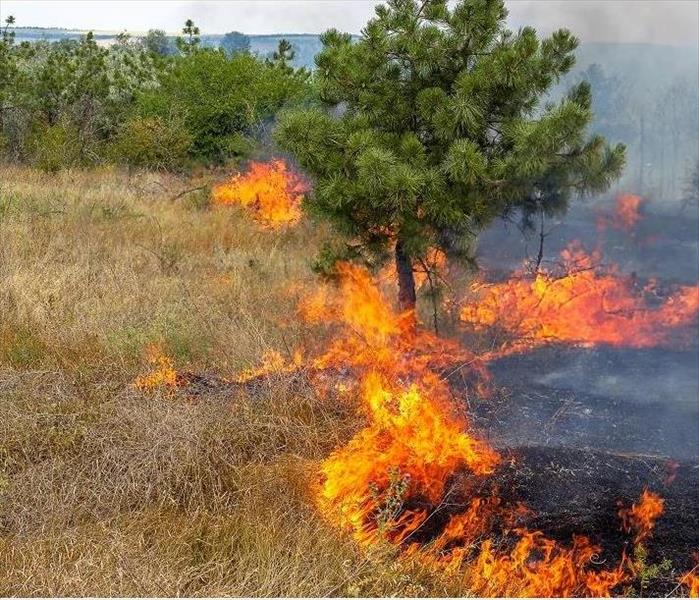 Wildfire damage
Wildfire damage
If a fire occurs in or near your Salt Lake City, UT, home, you may think the worst is over once the flames are extinguished. Yet that is not the case. Fires can lead to flooding, as well. After a fire, your home will likely have holes in the roof and walls. Water from a storm could enter your house through these holes. Even if your home itself was not affected by a fire, a wildfire near your property could make it more susceptible to flooding damage.
Wildfire Damage and Floods
When wildfires burn through the terrain, they destroy vegetation that typically absorbs rainfall. As a result, the ground is left:
- Barren
- Unable to absorb water
- Charred
It can take up to five years for vegetation to re-grow after a wildfire. Until then, the areas surrounding the damage will be more at risk for flash floods. The rainwater from storms may also pick up sediment and soil as it moves across the charred ground. This could lead to harmful mudflows.
Unfortunately, most homeowners’ insurance policies do not include flood coverage. If your house floods, even if the flood results from a wildfire out of your control, you could be responsible for the full cost of professional restoration services.
This flood cleanup can be quite expensive, as well. In 2010, an average flood claim cost $28,000. In fact, just 1 inch of water in your home can lead to $25,000 worth of damage.
Thankfully, you can purchase separate flood coverage via the FEMA NFIP. The National Flood Insurance Program offers insurance to both renters and homeowners.
Getting Flood Coverage
If you live in one of the 23,000 participating communities, you are eligible for the NFIP. In fact, if you live in a high-risk area and have a mortgage from a government-backed lender, you are legally required to obtain flood coverage. Your insurance agent can help you purchase a flood policy through the NFIP. There may be a 30-day waiting period before the coverage goes into effect.
The cost of this coverage varies based on your property’s flood risk. If you want to lower your premiums, you can enact flood mitigation measures. For instance, you can elevate your utilities and fill in your crawlspace or basement.
Other Steps To Take Before the Next Flood
Once you have purchased flood insurance from the FEMA NFIP, you should take additional steps to prepare your home and family for the next major storm. Gather all necessary supplies so you will not have to drive to the store in the middle of a storm.
You should also keep an inventory of the various items in your home. This will be important information for the insurance adjuster. Any important documents, such as birth certificates, should be kept in a waterproof location.
In extreme situations, you may be asked to evacuate your house ahead of the storm. Plan a safe evacuation route, and make sure that everyone in your home understands it.
Thanks to the FEMA NFIP, you can purchase insurance that covers the cost of restoration after a flood. This is particularly important if you live in a community prone to wildfires.
Steps of the Fire Restoration Process
7/14/2022 (Permalink)
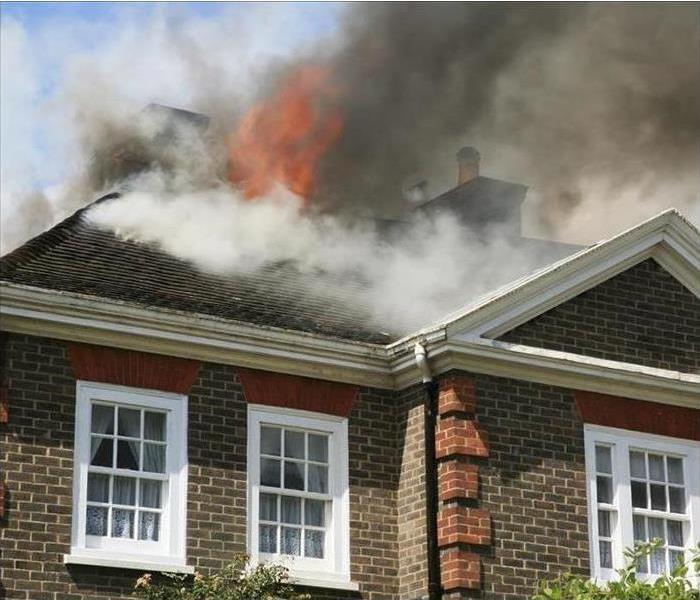 This house is on fire. Even a small number of flames can cause a significant amount of fire damage.
This house is on fire. Even a small number of flames can cause a significant amount of fire damage.
Even a small number of flames can cause a significant amount of fire damage. Here is what the process looks like when technicians from a fire restoration company in Salt Lake City, UT, arrive at your home.
5 Steps Of The Fire Restoration Process
- Assessment
The first thing specialists have to do is analyze the problem. There are several components to this assessment:
- Noting the extent of the destruction
- Identifying the areas with water damage
- Detailing the processes needed to restore the structure
- Extraction
A fire hose expels a lot of water in a short amount of time. This is great for getting rid of the flames, but the water needs to be extracted from your home quickly to minimize the damage it can cause. Technicians pump out standing water and debris and extract excess moisture from surfaces.
- Removal
All affected items and materials are removed from your home during fire damage mitigation. Saturated dry wall is torn out and damp or smoky insulation is discarded. Flooring and ceiling materials must go, too. All damaged belongings must be inspected to determine whether or not they are salvageable.
- Cleaning
There are three steps to the cleaning stage. The first is the removal of smoke and soot particles from every surface, crack and crevice. The second is the disinfection of everything the water used to put out the fire touches to rid your home of bacteria or fungus that may have started to grow in the moisture. The third step involves purifying the air to rid your home of unpleasant odors.
- Restoration
Once the remaining structure is cleaned, it's time to rebuild. Technicians put up new walls and match the paint or wallpaper to what was already there. All new flooring may be in order if your carpets or tiles aren't able to be patched.
Restoring your home after a fire involves multiple steps. After the water and fire damage are repaired, the structure can then be rebuilt.
3 Steps To Take After a Home Flood
7/14/2022 (Permalink)
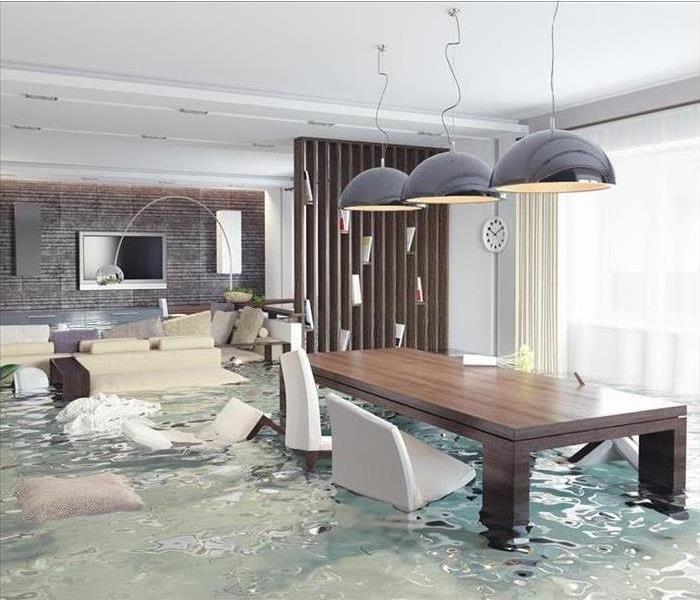 Flooding can lead to severe damage.
Flooding can lead to severe damage.
Even if you don't live near a water source a home flood can happen to you. It is important to have a plan in place before a flood occurs so that you can minimize the amount of damage to your home. Consider including these three steps in your flood plan.
3 Steps to Include in Your Flood Plan
- Contact Your Insurance Company
Most homeowners policies exclude flood damage; however, some types of storm damage may be covered. If you have a separate flood insurance policy, you should contact the insurance company to file a claim. Because floods can cause extensive damage that requires water restoration services, it is a good idea to purchase flood insurance, even if your home is not located in a high-risk area.
- Begin Cleanup As Soon As Possible
You should not attempt to reenter your house after a home flood until local authorities say it is safe. However, as soon as you are able, you should begin the cleanup process. Avoid coming into contact with floodwaters. Most homeowners should contact a restoration company in Salt Lake City, UT, rather than attempt a do-it-yourself solution. Standing water can be a safety hazard and flood damage can be very difficult to clean without the right equipment and training.
- Dry Out Your Property
The longer your property stays wet, the more likely you are to have issues with rot, mold and other damage. Anything that can not be completely dried out should be discarded. If it is safe to enter your home, you can begin removing wet contents and placing it outside to dry if the weather permits. Some amount of drying can be accomplished by using fans and dehumidifiers, but professional equipment may be necessary.
The damage that occurs during a home flood will continue to get worse the longer it takes to clean and dry the property. Taking the proper steps after a flood can prevent unnecessary additional damage.
Smoke Alarms and Your Family's Fire Safety Plan
6/22/2022 (Permalink)
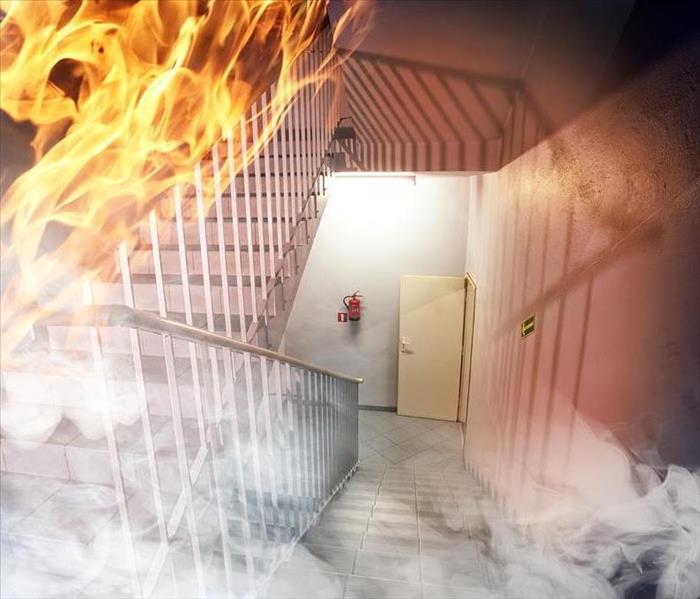 You can Avoid important Fire Damage by Following our Tips.
You can Avoid important Fire Damage by Following our Tips.
According to the U.S. Consumer Product Safety Commission, smoke and gases put homeowners in danger faster than flames during residential fires, and the majority of these dangerous fires happen when victims are sleeping.
A smoke alarm provides vital additional moments for escape, but to enjoy the benefits of safety devices, they must be placed and maintained appropriately:
- According to manufacturer instructions
- Inside each bedroom
- On each floor of the home
- Outside bedrooms
- In rooms where fire risk is higher
Unfortunately, many homes in Salt Lake City, UT, and surrounding communities don’t have working alarms or enough detectors. Take a few moments to determine the best smoke detector plan for your home.
Answers to Common Questions About Your Smoke Alarm and Fire Safety Plan
Which type of device is best?
There are several options available today, including ionization, photoelectric, and combination. Ionization alarms are best at detecting fires that burst into flames rapidly while photoelectric devices track smoldering, smoky fires best.
Most experts recommend using both types or combination detectors in your home. Test your alarms once a month and replace batteries at least once a year. Most devices should be replaced after 10 years; some need to be switched out more often.
What are smart smoke detectors?
These devices come in both ionization and photoelectric types, and they work in the same way that traditional alarms work. However, smart devices also send an alert to your smartphone, connect several smart detectors, and may work with other smart features throughout your home. This improves your chances of responding quickly to a fire.
What are the most important features of fire alarms?
In addition to making sure you have both types of detectors, make sure you have a reliable source of power for each alarm. Battery-powered devices are a good option in older homes, but new construction provides a chance for connected systems that run on your home’s electricity with a battery backup. Hard-wired systems that are interconnected provide more escape time. Some alarms have voice features that may be more effective at waking children when detectors sound.
What should our fire safety plan include?
Create a fire escape plan with multiple escape routes (preferably two for each room) and practice these routes with your family often. Make sure your family members know where to meet after evacuating your home. Make sure that you practice your escape from every room in the home and practice during the day and night. In the best-case scenario, your children will respond automatically to leave the home immediately when an alarm sounds.
What about putting out fires?
Naturally, the best answer is prevention. Talk to your fire department about the steps you can take to reduce the risk in your home. Use this opportunity to become familiar with fire extinguishers and how to use them. Your quick action could prevent a small fire from spreading.
Your most important action during a residential fire is making sure that you and your family are safe once the smoke alarm sounds. Once you leave the home, don’t return for any reason. Any damage that occurs to the home can be repaired by home restoration professionals but treating the physical and emotional harm to family members is harder.
Got a Sewer Backup? Get Professional Cleanup Help
6/17/2022 (Permalink)
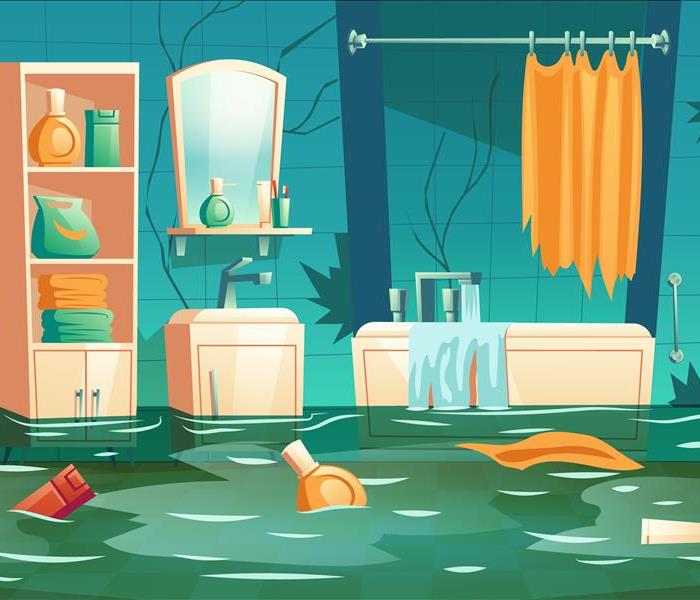 Got a Sewer Backup? Just call Our Specialists!
Got a Sewer Backup? Just call Our Specialists!
As a homeowner in Park City, UT, you want your home to be a safe and welcoming place. If you come into find the sewer has backed up, it means black water is seeping into the porous materials in the home and potentially spreading. Sewer cleanup requires extra attention to safety, which is why it’s best to call a water damage and restoration company to handle the mess.
Important Steps in the Cleanup Process
Sewer Backup Cleanup Process
Black water, classified as Category 3 by the IICRC, means that there are potential contaminants, bacteria, chemicals and microorganisms lurking within it. Even a flooded toilet may be in this category, so it’s important to not just dive right in.
Sewer Cleanup Process
When you hire a professional company, you get peace of mind that the entire problem will be handled by one trusted company. Trained and certified professionals will have the expertise, safety gear and industry-grade tools to get your home back to like new. While every situation has different degrees of severity, the cleanup process typically involves the following steps.
- Containment: Containing the affected area is the first vital step. This will help ensure that secondary damage doesn’t spread to other areas.
- Extraction: Standing water and waste will be extracted using high-grade pumps and other tools. The waste and contaminated water will be properly disposed of. Water-logged belongings will also be removed and taken off-site to be inspected for salvageability.
- Dry Out: Air dryers and movers, along with dehumidifiers, will be used to thoroughly dry the area.
- Clean, Sanitize, Deodorize: After the area is dry, the real cleaning process begins. An array of industry-recommended cleaning methods will be used to ensure peace of mind.
- Restoration: The final, and often longest step, involves restoring the property to preloss condition. This may include replacing drywall, carpeting, flooring and other structural components depending on the degree of damage.
Prevention Tips
Once you have dealt with a sewer issue, you don’t want a repeat situation happening. While there may not be much a homeowner can do if it was due to a city sewer issue, there are ways to minimize the risk in regard to your sewer line.
If it’s been a while since you have had your plumbing inspected, now is a perfect time. A professional plumber will inspect the valves and pipes to ensure they are working properly and have the know-how to detect potential problems.
The easiest way to keep your sewer working right is to practice good habits. Avoid flushing chemical products or any items other than waste and toilet paper down the drain. In the kitchen, ensure that grease is being properly thrown away and not going down the drain. This causes a buildup in the pipes that will eventually affect the main sewer.
While trees add to a property’s aesthetic, know where your sewer pipes are before planting. Tree roots will quickly make their way through older pipes, causing an eventual clog or collapse.
Sewer cleanup is a messy job and one that requires adhering to strict safety protocols. Instead of dealing with it on your own, it's best to consider hiring a professional to handle the job from beginning to end.
What You Should Know About Water Damage
6/13/2022 (Permalink)
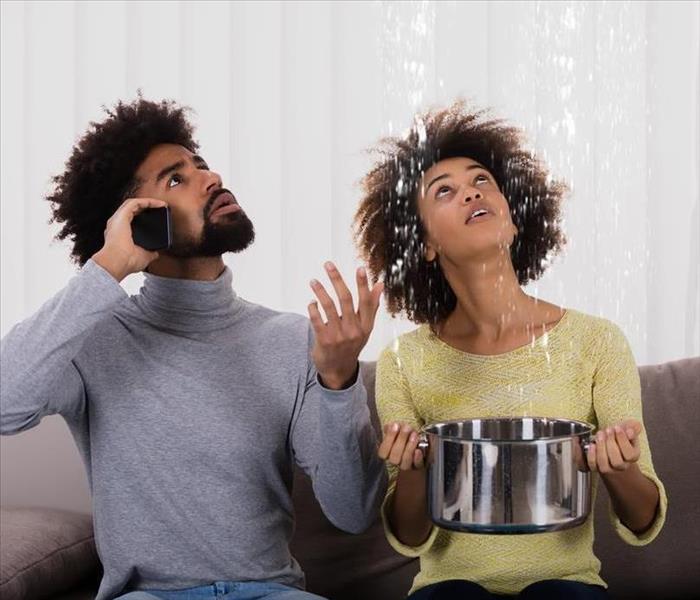 Follow our tips and Know more about Water Damage.
Follow our tips and Know more about Water Damage.
Water damage involves apparent (and not-so-apparent) destruction that comes from the presence of water in places that it shouldn’t be, especially for an extended length of time.
Damage can range from something as minor as a leaky water line to a refrigerator to something more catastrophic such as flooring or sewage backup.
Unattended water issues can impact building materials, compromising the structural integrity of your home. Water also creates the right environment for the growth and spread of mold. Cleaning up water quickly is an important part of taking care of your home.
Categorizing Water Damage
Damage from water falls into three categories, based on the source and severity of contamination:
Category 1:
The least severe category of damage, this water usually comes from broken pipes or overflow of a sink. Category 1 water is free of toxins and sewage, and usually the places impacted are also clean. Sometimes this water is called clean water.
Category 2:
Water in this category probably contains some contaminants and should be cleaned as quickly as possible. Also known as grey water, this damage usually comes from toilets (without feces), sump pump backups, and discharge from appliances such as dishwashers and washing machines that clean dirty objects. Clean water that has been standing around for more than 48 hours can become category 2 water.
Category 3:
Also known as black water, this category includes water that is severely contaminated with bacteria, fungi, and other microbes. Category 3 water sources include toilets containing feces, groundwater, outside flooding, and sewage backup among others.
Grey water that hasn’t been removed or cleaned in 48 hours should be handled as black water.
While clean water can usually be safely handled through drying, different types of water damage require approaches. Because this damage can lead to severe problems, it’s important to reach out to your nearest SERVPRO franchise in Salt Lake City, UT to professionally clean and remediate damage in any category.
Understanding the Cleanup Process
Generally, the water cleanup process should include the following steps, some of which should be left to the professionals:
- Shut off the water: Before you do anything else, make sure to stop the flow of water when applicable. Turn off the main supply to your home before proceeding further.
- Turn off the power: Electric and electronic items may be affected by water damage. It may not be safe to unplug items, so cut off the electric supply to affected areas using your breaker box.
- Check for mold: Mold may be visible on some surfaces. You may also detect a musty order. Because mold can grow and spread under floors, behind walls, and in ceilings, your professional damage restoration provider is equipped to remove structural elements to assess the extent of the spread.
- Remove the water: Remove excess water with buckets, vacs, or through drying, where possible.
- Remove damaged objects: Water-soaked carpet, drywall, insulation, and other materials should be physically removed.
- Disinfect and sanitize: Grey and black water involve contaminants that should be thoroughly cleaned.
Water damage is serious business at your home in Salt Lake City, UT. The longer it’s left unaddressed, the bigger your problem. Reach out to the professionals who are equipped to return your home to pre-damage conditions with special approaches to cleaning, drying, repair, and reconstruction.
How To Make a Flood Claim?
5/24/2022 (Permalink)
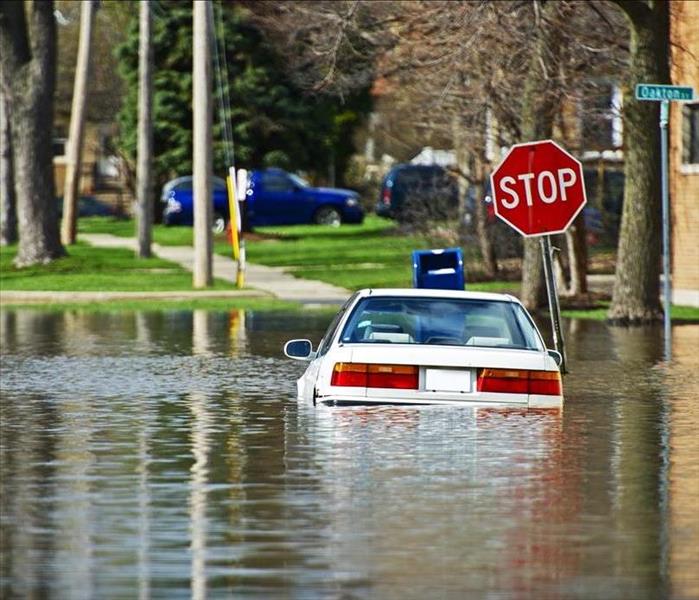 Learn how to make your Flood Claim by Following These Tips.
Learn how to make your Flood Claim by Following These Tips.
Floods can cause devastating damage to homes. The first step to restoring your property after a flood is to file a flood claim.
How To File a Flood Insurance Claim
Filling your claim for flood damage is a multi-step process:
1. Contact the Insurance Company
The first thing you must do is contact your insurance company. Most homeowners insurance does not cover flood damage so your flood insurance may be with a different insurance company than your homeowner's insurance. If you aren't sure who your insurance carrier is, you can call the National Flood Insurance Program Call Center at 1-800-427-4661 to find out.
2. Provide Information
Your insurance company will need several pieces of information. This may include your policy number, a phone number and email address where your insurance company can contact you and the name of your mortgage company if you have one. If you don't know all of this information, your insurance or claims agent may be able to look it up for you.
3. Document Your Damage
It usually takes 24-48 hours for your insurance company to assign an adjuster to your claim. However, if flooding is widespread, it may take longer. While you are waiting, take photos and videos of your damaged property and the flood lines on the outside and inside of structures. Photograph the make, model and serial number of electronics and appliances. Do not enter flooded areas or structures until you have been told they are safe.
4. Discard Flood Damaged Items That Are Unsafe
After you take photos and keep samples of materials such as pieces of carpet, flooring, drapes or wallpaper, throw away flood-damaged items that are unsafe to keep, such as perishable food, cushions, clothing and pillows.
5. Contact Repair Services
If the electrical, HVAC or water systems of your home are damaged, contact repair services. However, talk to your insurance company about your flood claim before you sign any contracts. This is also a good time to schedule a flood remediation company in Park City, UT, to begin drying and cleaning your damaged home.
6. Meet With the Adjuster
When the insurance adjuster arrives, ask to see the adjuster's Flood Control Number card and other official identification. This protects you against scammers who may be posing as insurance adjusters. Review the adjuster's written report and estimate for any errors. A legitimate insurance adjuster will not ask you to pay your deductible, charge you a fee or ask for money for any other reason.
7. Receive Payment and Begin Repairs
Once the insurance company receives the adjuster's report and estimate, it will review the report, along with any documentation you have provided, to establish the value of your claim. If you disagree with the value the insurance company determines, you may need to submit additional supporting documentation to prove your claim. Once a settlement is reached, the insurance company will issue you a check and you can use the money to make repairs.
The flood claim process can be lengthy, particularly if there are many people in your area with damaged property. The faster you get the process started, the sooner you can expect to receive payment.
How Pretesting Property Reduces Insurance Claims
5/19/2022 (Permalink)
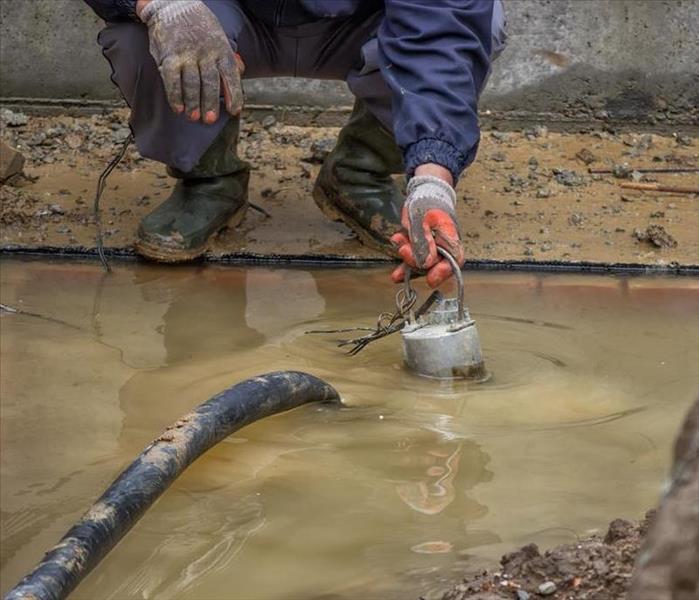 Know more about Insurance Claims. If you have more doubts, just contact us.
Know more about Insurance Claims. If you have more doubts, just contact us.
Is pretesting for damage before claim approval in your customer's best interest? Is the procedure helpful to you, the insurer? Our locally owned SERVPRO franchises seek to help both sides, satisfying our clients and their insurance agencies. Staff members in Salt Lake City, UT work to provide vital data to guide both parties through the restoration and claim process. We can minimize future troubles and filings with swift action and early detection. Here are three main points to know and understand.
Important Points to Know about Insurance Claims
1. Awareness Reduces Insurance Claim Costs and Secondary Damage
Water damage requires intense cleanup because the moisture harms the building and items. Improperly treated or untreated water damage leads to several problems, particularly mold and mildew. Water sits idly within objects and materials, allowing spores to reproduce. These microbes multiply quickly. Within a day or two, an infestation can spread throughout a room.
Without early testing, commercial owners may miss critical steps in the repairs, focusing on the drying procedures and ignoring the potential for eventual growth. What if a room is saturated but isn't visibly detectable? The fungus could grow, requiring a claim in a few months or a year. Furthermore, people may realize that personal objects such as chairs and clothing received impact, requesting property loss reimbursement months after the event.
Prompt detection allows clients to file simultaneously and reduces confusion and debates.
2. Testing Focuses on Immediate Needs and Future Complications
When owners call a team for help, the crew arrives ready to complete a thorough pretesting evaluation. They look to the source, immediately working to resolve the problem. By stopping the water flow and identifying the origin, owners and agents have less to fix.
It's about the present and the future, so experts then begin collecting specimens to note the level of contamination. Air and physical collections provide a clear overview of whether microbes have set into the walls, floor and belongings. Moisture reading tools detail the extent of fluid saturation, and inspections occur within various rooms to note deterioration and structural concerns.
The goal is to identify both visible and invisible sources of immediate and long-term hazards. Catching trouble early allows for early intervention and reduces owner claims.
3. Testing Informs Insurance Agents About Property Conditions
When proprietors submit a claim, you, as the insurance agent, want assurance that this problem did not result from prior negligence or misconduct. Did an owner know that the water heater was leaking? Was there an underlying problem that they should have caught earlier? Business leaders often underestimate the potential for mold and water development from something minor, but it does matter. You need this factor ruled out before you release a claim check.
After an early investigation by remediation professionals, agencies and clients receive a detailed report noting how something happened, what experts can do about it and how the team could prevent future contamination issues.
Pretesting benefits both the commercial owner and the insurer, guiding both through the restoration process and understanding the impact of the damage. Using innovative technology and reacting quickly allows SERVPRO to get ahead of issues, minimizing additional claims.
What To Do If Your Commercial Building's Roof Is Damaged in a Fire
5/11/2022 (Permalink)
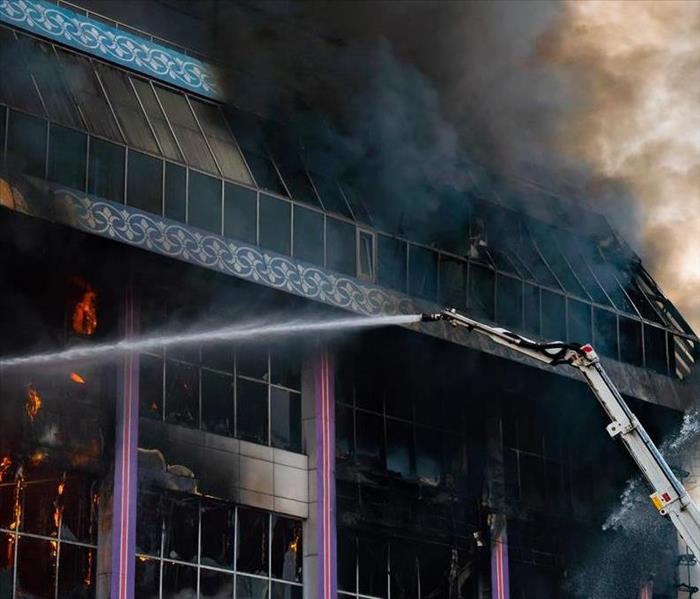 If Your Commercial Building's Roof Is Damaged in a Fire, just Call the Professionals.
If Your Commercial Building's Roof Is Damaged in a Fire, just Call the Professionals.
Even a relatively small fire can cause major damage to your Park City, UT, commercial property. The flames could burn important documents, and the smoke odor could permeate carpets and furniture. However, there can be other causes of harm. Firefighters often cut holes in the roof of a burning property to prevent the flames from growing. This strategy removes the dark smoke that can hinder the firefighters’ visions as they battle the flames. Yet it also necessitates roof repair after the fire has been extinguished.
Hire a Tarp Services Provider After a Fire
You should hire fire cleanup professionals who will put a tarp on your property. A tarp can temporarily cover any holes in the roof, keeping out the elements until the roof has been fully repaired. The experts should also board up the doors and windows so vandals cannot enter the premises. Here are three other steps to take if your roof is damaged in a fire.
1. Call Your Insurance Provider
While professional restoration services can be expensive, the money from your insurance policy should cover at least some of this cost. Ask your insurance representative for a written estimate. You should also ask the rep what else you can do to minimize further harm to the property.
If you do not have property insurance, or if your coverage is limited, you may be able to find help from other sources. Local organizations and public agencies often provide emergency funds. You could also ask the Salvation Army or American Red Cross for assistance.
2. Stay Safe
Do not re-enter your building until firefighters say that you can. After they are done putting out the flames, they will check your gas and electricity systems. Any rainwater that does enter the property through your damaged roof may affect these utilities.
If the utilities are unsafe to use, the firefighters will disconnect them. The fire cleanup experts should tell you when it is safe to turn on the utilities again.
Even if you are given permission to enter the property, you should still be extra careful. Walls and floors may not be as sturdy as they appear.
3. Replace or Restore Valuables
Your commercial property likely has important documents, such as tax records and insurance policies. A fire could burn these documents directly, or it could cause a roof defect that leads to weather elements harming the documents.
You may be able to obtain new copies of some of these items. However, more proprietary documents may be tough to replace. Try to find restoration experts who can salvage important paperwork. Be sure to save the bill or receipt from the remediation company. You may have to show it to your insurance provider.
Excessive roof damage can make the fire cleanup process more difficult. However, by taking advantage of tarp services, you can limit any harm caused by a hole in the roof. Calling your insurance provider, keeping off your utilities if necessary, and having important documents restored or replaced should also expedite the recovery.
What Role Does the Federal Emergency Management Agency Play After a Storm?
5/7/2022 (Permalink)
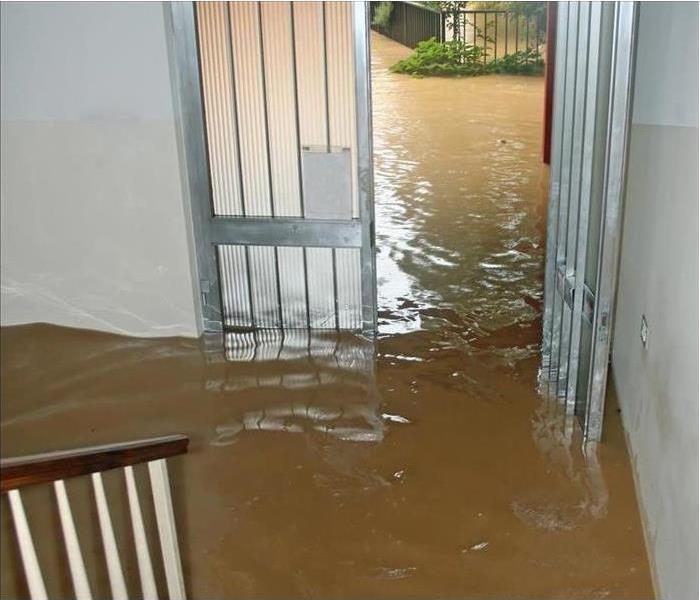 Take into account these tips and Avoid Storm Damage in your Property.
Take into account these tips and Avoid Storm Damage in your Property.
Wherever you reside, the unthinkable could occur at any time. When a disaster devastates your property and others' in Salt Lake City, UT, you'll probably feel overwhelmed and unsure of what to do next. If the loss is significant enough, the Federal Emergency Management Agency may be dispatched to the scene.
FEMA was formed in 1979 to "lead America to prepare for, prevent, respond to and recover from disasters with a vision of 'A Nation Prepared.'" For example, it assists survivors of disasters such as severe flooding in rebuilding their lives. It has helped with numerous tragedies in the past and continues to now. It serves several important roles, including the following.
4 Roles FEMA Serves After a Storm
- Assessing the Affected Areas
First, it performs detailed assessments of the area in which tragedy has hit. It determines what type of assistance the victims require. These needs can vary depending on the kind of disaster. It basically operates as the "boots on the ground" for everything from hurricanes to wildfires to terror attacks."
- Acting as a Liaison Between Federal and Local
It acts as a liaison between the affected area and the federal government. Various factors are controlled physically and financially by FEMA. It usually involves allocating supplies, maintaining resources and working with local and state officials.
- Determining the Appropriate Response
It determines the required response and assembles the appropriate troops. Law enforcement, for example, may be needed. Hurricanes and other kinds of disasters can bear several types of significant losses. This can include damage from wind, flooding and even fires.
- Coordinating the Response
Finally, it helps coordinate responses such as mobilizing troops to evacuate people, provide tarps for roofs and distribute food and water. It also locates and provides shelter and other basic needs for displaced victims.
Although FEMA takes significant control after a disaster occurs, their help is no substitute for insurance. If you have a flood or other kinds of loss, storm damage remediation experts will likely also be necessary. They can return your home to its preloss condition as quickly as possible.
Does Your Homeowner's Policy Cover Water Damage?
5/7/2022 (Permalink)
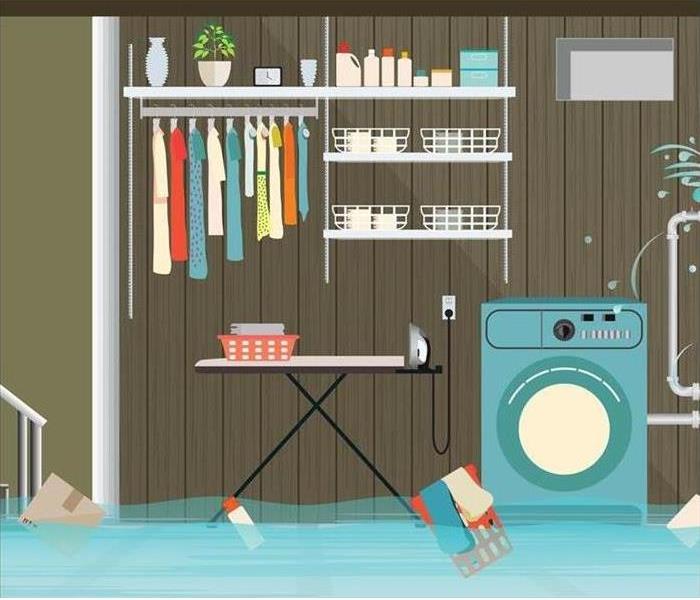 Learn more about Your Homeowner's Policy by following Our Tips.
Learn more about Your Homeowner's Policy by following Our Tips.
Many homeowners who experience a basement flood or water damage are concerned about the cost for a remediation and restoration company in Salt Lake City, UT. However, while the general thought is that your insurance coverage will not cover water damage, that is likely not entirely accurate.
Most homeowner's policies will cover some water damage, but it is vital to know the specifics surrounding each situation, those covered and not.
4 Situations That May Need Insurance Coverage
- Accidental and Sudden
Most insurance companies will cover accidental or sudden water loss. Therefore, if you experience a pipe break or if your water heater suddenly failed and flooded your basement, your policy will probably cover some of the resulting damage, like structural issues or drywall damage. However, not every plan will include the damaged component or appliance that caused the problem.
- Unresolved Maintenance Issue
Nearly all insurers will refuse to cover unresolved maintenance issues that result in a basement flood. If you know about a leak, or if you have an appliance that is well past its prime, then you will likely have to pay for any resulting damage.
- External Flood
If you live in a flood zone, or if you are concerned about the possibility of a flood, make sure you have flood insurance. A standard homeowner's policy will not cover flood damage. While most homeowner's plans will not cover flooding, if you are in a flood zone, it is a possibility that flood coverage is regulated and required.
- Outside Source
Sewer backups or other external causes for internal water damage are also likely not covered by your homeowner's policy. Check with your insurer to be sure.
It is vital to know what you are protected against through your standard insurance plan. If necessary, you can purchase more coverage from other insurers to ensure that your home is protected against a basement flood.
If you have concerns about your protection needs, consider talking to a remediation company in your area. They can assess your property and give you advice about possible mitigation and preventative steps you can take.
Safely Use a Plumber's Snake To Fix Your Clogged Pipe
4/21/2022 (Permalink)
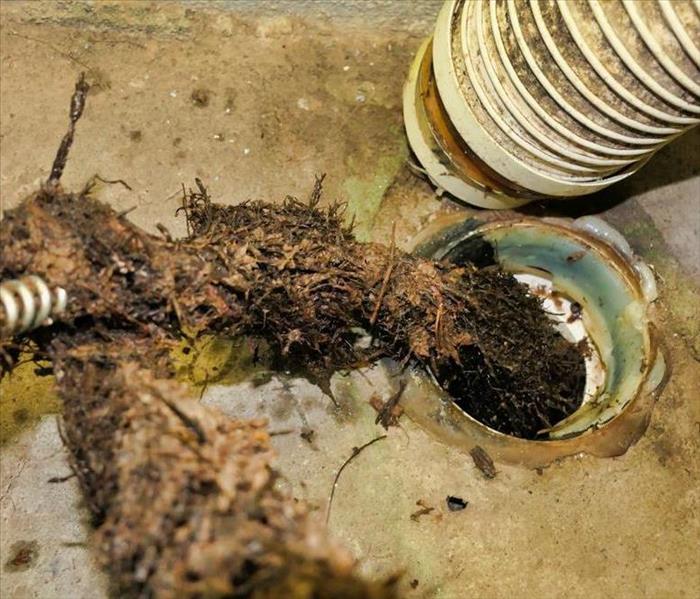 Learn how to Safely Use a Plumber's Snake so as to Fix Your Clogged Pipe.
Learn how to Safely Use a Plumber's Snake so as to Fix Your Clogged Pipe.
A clogged pipe can quickly lead to water damage and the need for repairs. In Salt Lake City, UT, SERVPRO professionals respond Faster to Any Size Disaster, helping you avoid serious disruptions to your normal schedule. Sometimes, however, clearing a clog on your own is possible.
How To Snake Your Clogged Pipe
Clearing the pipes may be a messy chore, but it prevents more significant trouble, such as a pipe break or sewer system backup. To get started, you'll need a few tools:
- Plumber's snake
- Bucket for garbage
- Rags for cleanup
- Gloves and goggles for your comfort and protection
Most drain snakes are generic and can be used for multiple drains and pipes. However, there are some snakes specifically for toilets or showers. If you have questions, ask for advice from an experienced plumber or property maintenance professional. Once you've gathered your tools, clear the area and spread out rags to protect the floor from water damage.
Try Other Options
Before pulling out your plumbing snake, you could try other methods of unclogging the drain, such as a combination of baking soda, vinegar, and boiling water. This mixture may dissolve a variety of organic clogs. You could also try using a plunger, forming a vacuum seal, and pulling out the obstructions.
Remove Visible Obstructions
Pushing the snake into your drain often results in shoving stopped objects further into the pipes. This can compound the clog rather than clear it. Before taking this step, pull out all of the objects you can see. This includes hair, food, and other items that shouldn't be in the drains:
- Fats, grease, oil
- Soap buildup
- Hard water minerals
- Inappropriately flushed items
Understand How the Snake Works
A plumbing snake consists of a handle, a flexible pole, and a rotating auger. As you slide the snake into the drain and connecting pipes, rotate the handle. This extends the tool up to 50 feet long. As the auger turns, it should break through blockages, loosening the clogged materials and allowing the debris and the water to flow through as intended.
When you feel resistance, you may have reached a corner or the obstruction. Move the head back and forth and from side to side. The snake should turn the corner or break through the clog.
If the head is stuck or if you hear a scraping sound, use the handle to retract the snake. Either the obstruction will come back with the auger, or you can try one more time. It may be necessary at this point to contact a plumber to remove the obstruction. It is possible to damage your pipes with a drain snake, so don't proceed if you aren't sure of yourself.
Perform Routine Maintenance
In general, using a drain snake is a task you perform after a clog has formed, and it's pretty common to use the tool once or twice a year. However, proper maintenance and system assessments are important steps in enjoying a smoothly operating water system. The cleanup and repair professionals at SERVPRO can help you recover from water damage. With consistent maintenance and attention, you can avoid many clogged pipes and related troubles.
Best Tips for Dealing With Puffback Damage
4/13/2022 (Permalink)
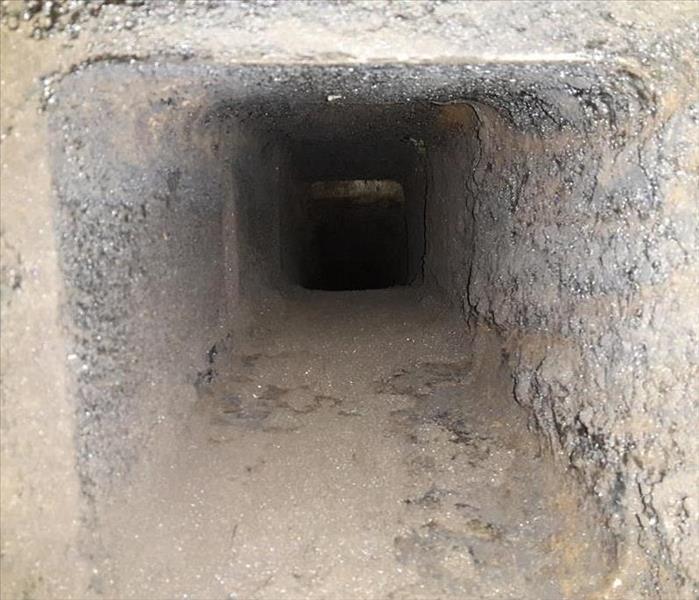 Repairing Puffback Damage needs Experienced Hands. For more questions, contact us.
Repairing Puffback Damage needs Experienced Hands. For more questions, contact us.
A puffback takes place when your oil-burning furnace fails to ignite properly due to clogs, leaks, and other issues. It’s also a sign that your heating system demands the attention of a serviceperson.
Because your system is connected to multiple rooms, this blowing back of soot and smoke not only contaminates the air, but it also leaves a sticky residue on various surfaces that requires the equipment and cleaning techniques offered by a professional restoration services provider. If you experience puffback damage in your property in Park City, UT, here’s what you should know about dealing with the aftermath.
Important Steps After Furnace Puffback
If you detect evidence of puffback or experience it when operating your oil furnace, take the following steps first:
Call 911: Because a puffback happens due to an explosion, you’ll need the fire department to either extinguish any fires or confirm that there are none.
Shut down: Turn off the power to your furnace and heating system.
Evacuate: A furnace puffback increases the level of carbon monoxide in your facility, so exit the premises as quickly as possible.
Open up: Open windows and doors if possible on your way out.
Unplug: If safe, unplug electric and electronic devices as you exit the building
Discard: After returning to the building, throw away food and other perishables with soot and smoke damage.
Call: Schedule a certified technician to repair your furnace and hire professionals to clean affected rooms and belongings.
The Need for the Professional Touch
Cleanup of puffback damage requires a professional approach for multiple reasons:
DIY cleaning methods aren’t effective for removing smoke and soot from surfaces. In fact, often these approaches can exacerbate the situation. For example, vacuuming will push soot particles deeper into carpets, rugs, clothing, and upholstery, leading to permanent stains.
Special cleaning techniques prevent soot and odors from being embedded in walls, floors, and ceilings. It’s impossible to cover the oily residue with primer and paint.
Glass, metal, and other surfaces are susceptible to corrosion and other damage if left exposed to smoke and soot.
Furnace puffback will not only cover every surface, but particles may end up in cracks and openings below floors, behind walls, above ceilings, and other difficult places to reach.
Your damage restoration services provider has the experience, equipment, and expertise to restore your property to pre-damage conditions, including cleanup of damage due to fire and water if needed. The experts will prioritize cleanup and repair over replacement to help control costs. If your building requires reconstruction, the pros can take care of that also. While you hope to never experience puffback damage in your building, it’s important to be aware of the gravity of the situation.
Assessing the immediate damage, fixing your heating system, and cleanup should only be handled by the pros, namely the fire department, a certified technician, and a restoration services provider respectively.
This is your charge as a responsible property owner, committed to proper maintenance and upkeep for the benefit of your building occupants. Keep in mind that insurance companies prefer to work with professional restoration companies
What To Know About Making a Residential Water Damage Claim
4/9/2022 (Permalink)
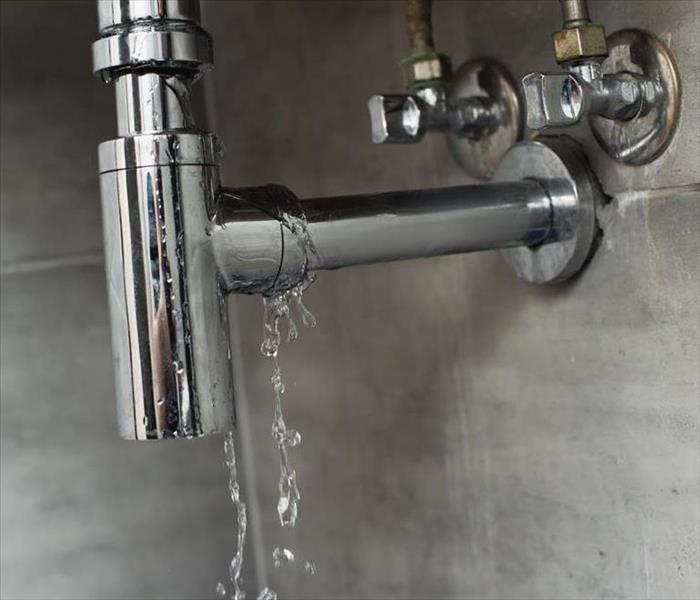 Know More about Residential Water Damage Claims by Following our Tips.
Know More about Residential Water Damage Claims by Following our Tips.
Making a water damage claim for your home can be a stressful experience. That is because homeowners' insurance policies are often confusing. Typically, damage caused by emergency situations, such as bursting pipes, is included in your policy. Other types of damage that may be covered include:
- Sewer backup
- Floods
- Storms
- Overflow
Yet even a robust policy does not cover all kinds of damage. Here are some things you should know before making an insurance claim.
When Is Water Damage Covered by Insurance?
Your insurance policy should cover a sudden and accidental discharge of water in your Salt Lake City, UT, home. However, most policies exclude coverage for gradual damage that occurs over an extended period.
Over time, parts of your home will experience wear and tear. This could result in water damaging various parts of the house. For instance, basement cracks could cause liquid to seep into the lower level of your home. A leaky pipe could also lead to a buildup of water inside your walls.
Insurance companies believe that you need to take reasonable steps to care for your home. That means inspecting the property regularly and fixing any issues right away. If your house suffers gradual damage, the insurance company will assume that you were negligent in your maintenance of the home and will likely deny your claim. You will then have to pay for water restoration services yourself.
Still, even this general rule has some exceptions. You may have to pay to replace or fix broken pipe yourself if the harm to the pipe occurred over time. However, the insurer may still cover any resulting damage that occurred as a result of the break.
Another common yet complicated situation occurs when a tree falls onto a roof and creates a hole. Your insurance provider will likely cover the costs of fixing the hole and addressing any damage caused by the water entering your home through the hole.
Yet what happens if you notice new water or mold damage near the hole months after the repairs have been completed? In this case, your insurer may still cover this additional harm if it was also caused by the original roof hole.
In general, mold is not covered by home insurance policies. Yet you may have coverage if the mold results from bursting pipes or another covered peril. Ask your insurance broker if it is possible to add mold coverage to your policy.
How Can You Decrease the Chances of Your Claim Being Denied?
There are several things you can do to prevent the denial of your water insurance claim. First, make sure to purchase a policy that addresses all of your needs. Do not be afraid to ask about any add-ons, such as mold coverage.
Performing timely repairs of your home is important, as well. Your claim will likely be denied if the provider determines that you have not been taking care of your property. Keep records of all repairs that you or a third party has performed over the years.
While damage caused by bursting pipes is often covered by insurance, your provider may reject other water-related claims. By performing regular maintenance on your home, you should increase the odds of your claim being accepted.
Dealing With Flooding in a Commercial Basement
4/8/2022 (Permalink)
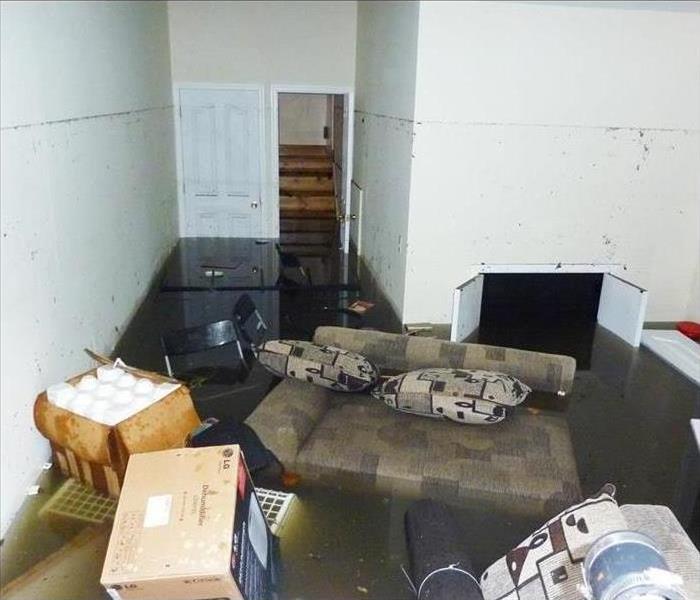 Follow our Tips and Learn More about how to deal With Flooding in your Commercial Basement.
Follow our Tips and Learn More about how to deal With Flooding in your Commercial Basement.
Commercial basements offer plenty of storage options, but knowing the possibility of a basement flood should make any owner question what they store in the lower level of their building. If you happen to have a flood, you should contact a water restoration service in Park City, UT, to assist in recovery. These services will typically come at a flood in a three-step process:
- Water removal
- Debris Removal
- Restoration
However, before contacting a professional service, you might want to contact your insurer to discuss your commercial insurance coverage. Depending on how the flooding occurred, it is possible that your policy could cover a significant portion of the restoration.
- Water Removal
The primary concern is the standing water in your facility’s basement. The longer it sits, the more problems can arise. The sooner a remediation service can get to your property and begin removing the water with shop vacuums, pumps, and pump trucks, the better.
When the water is removed, the service will attempt to dry out the basement as quickly as possible using fans, air movers, and dehumidifiers. Quickness is essential to reducing the risk of mold.
- Debris Removal
After a basement flood, many business owners have an instinct to salvage, but salvaging items might be impossible or irrational depending on the type of flood. The consensus among the restoration community is that any appliances or porous items touched by gray or black water should be discarded. Appliances might also need to be thrown away if submerged in clean water.
- Restoration
Once the flooded area is dry, and debris cleared away, the restoration company can begin making structural and cosmetic repairs. When this phase is complete, a business will look as it did before the disaster.
A basement flood at a commercial facility is something that requires immediate attention. Contact your insurance company to learn about your coverage, and reach out to a remediation service to understand your options.
Everything You Need To Know About Removing Shower Mold
3/21/2022 (Permalink)
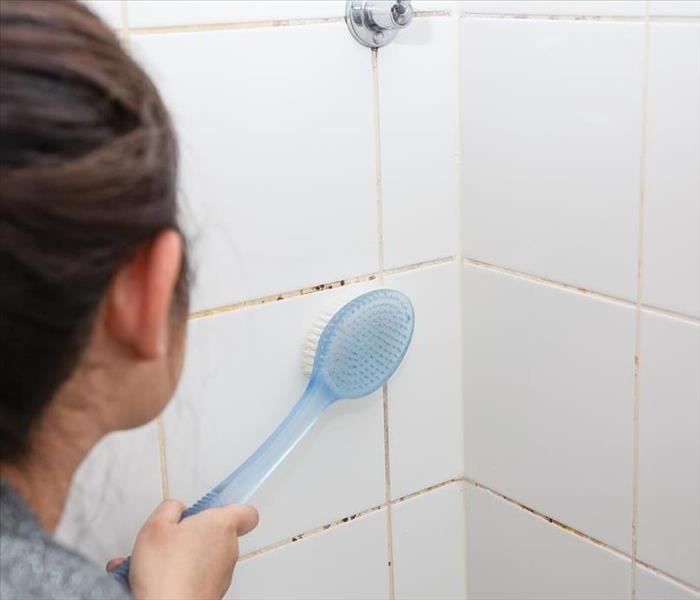 Learn More About Removing Shower Mold by Following These Tips.
Learn More About Removing Shower Mold by Following These Tips.
Shower mold is a disgusting reality. The smell and appearance are repulsive and agreeable to neither residents nor guests. Rid yourself of this mess the moment it appears and stop further growth. Here's a practical guide to eradicating fungal invaders.
Understanding Types of Shower Mold
Before cleaning your shower of mold, know what type you have. The categories of mold that exist include:
Black mold, also known as Stachybotrys is among the most concerning and demands caution. Wear protective gloves and breathing apparatuses for safety's sake. As soon as you notice the problem, refuse to allow anyone to use the facility. If you feel unsure about removing it properly yourself, hire a mold remediation specialist to do it for you.
Creating a Mold Removal Solution
You can use a homemade solution to take care of a moldy bathroom. One of the best is nothing fancier than white vinegar. Head to your local grocer in Park City, UT, and pick up a bottle. No dilution is necessary. It smells a bit, yet the aroma usually disappears within a couple of hours.
Borax is another effective option. Mix one cup with a gallon of water, then funnel the solution into your spray bottle. You can find what you seek in the laundry section of most stores.
Bleach should be a last resort. While effective at killing mold, care is necessary. Mix with plenty of water, and stay vigilant that children and pets do not touch it. Always keep the room well ventilated when using bleach.
Using Your Mold Removal Solution
Spray your solution on mold everywhere it appears. Exercise discretion and do not use so much that excessive liquid pools beneath. Avoid injury from slips by wearing shoes with rubber soles or staying on your knees.
Take a clean, dry cloth, and wipe down the affected area. The mold should come off without a problem. Alternatively, use a sponge designed for the task. Mold in certain areas may require extra effort. Employ a scrub brush to extract fungi from crevices between tiles and within hard-to-reach corners. Keep this tool nearby in case you missed any mold and growth returns.
Use a toothbrush on grout. Back and forth motions are advisable for best results. Rinse the brush as you clean to reduce the possibility of spreading spores.
Drying the Cleaned Area
Take a cleaning cloth, and sop up any remaining wetness. This task picks up bits of mold that have been scrubbed loose in addition to drying everything. Further, it lowers the odds of black mold coming back to haunt you. Swap out the cloth you're using for a fresh one once it becomes overly saturated or filthy. As a finishing touch, cover mold stains with commercially available caulking.
Ridding yourself of shower mold is vital for living in a comfortable home. Thankfully, the task does not require excessive struggle. Without a doubt, you will feel happier once invasive growths no longer haunt your washroom.
What To Expect During Restoration After a House Fire
3/14/2022 (Permalink)
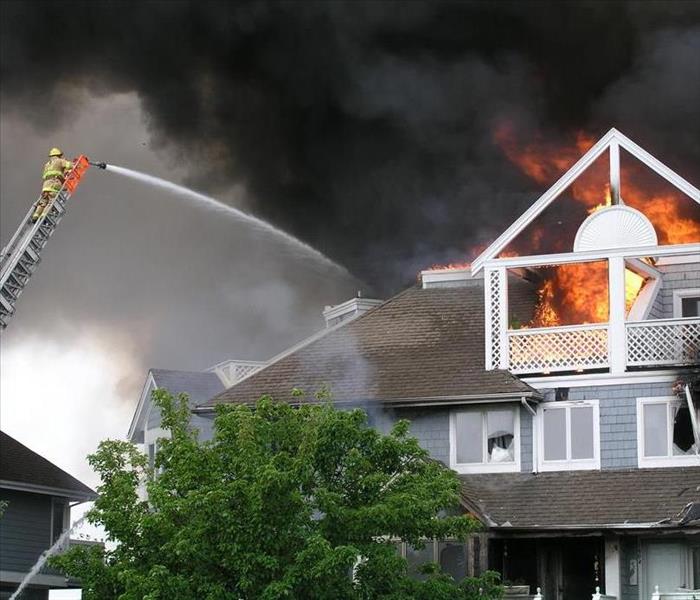 Learn More about Restoration After a House Fire, by Following These Tips.
Learn More about Restoration After a House Fire, by Following These Tips.
Even if the flames get extinguished before a total loss, a fire in your Salt Lake City, UT home still means dealing with the aftermath. After ensuring everyone’s safety and filing a claim, the next step is contacting a professional fire restoration company. Along with expertise with soot and smoke damage, a professional will also be able to properly correct any water damage sustained while the fire was being put out. Once the experts arrive, you can expect the following five steps to happen as they get your home back to once it what was.
Important Tips to Consider about Restoration After a House Fire
1. Damage Assessment
Before any work begins, an assessment of the damage needs to happen. First, it means ensuring the property is safe to enter. After that, the experts will inspect the property to determine the height of the flames, amount of water intrusion, contents affected and more. They will identify items that must be tossed, as well as possessions that will be able to be packed up to be taken to a secure site for deep cleaning and restoration.
This step provides the homeowner and insurer a solid understanding of how much work will be required, how long it will take and the estimated cost.
2. Property Securement
A key element of fire restoration is ensuring the property is secure. The last thing homeowners want is extra damage to an already damaged home. Work will be completed to board up openings and seal the roof to keep unexpected weather and intruders out. In some cases, a temporary fence will be installed. This step also involves removing perimeter debris and sealing off unaffected areas to reduce the potential of the damage spreading.
3. Dry Out
When it comes to damage cleaning, getting the home dry is critical. While that may seem strange when dealing with a fire, it’s likely a significant amount of water was needed to extinguish the flames. Water removal is essential to keeping mold and other secondary damage at bay. Professionals use industrial equipment to speed up this process, as well as have the knowledge and know-how to remove and water-logged materials prone to spreading the damage, such as drywall.
4. Cleanup
Before the home can be returned to its original state, deep cleaning must happen. The most intensive step of the process, it involves removing smoke and soot damage from all surfaces, inside and outside. Oftentimes, this will include cleaning the ducts to ensure that no lingering odors or damage is left behind. After cleaning, the home will be thoroughly deodorized and treated to eradicate mold growth.
5. Restoration
During this last step, repairs will be made to damaged areas. Depending on the extent of the damage, it may mean replacing or rebuilding the roof, walls, floors, cabinets and more. While it may seem overwhelming, it is a necessary task to ensure that the home is back to like new.
Dealing with a fire is never anything anyone wants to deal with. While fire restoration may not be a fast process, getting the right help means restoring your home to its preloss condition faster and more efficiently.
5 Tips To Minimize Commercial Winter Storm Damage
3/9/2022 (Permalink)
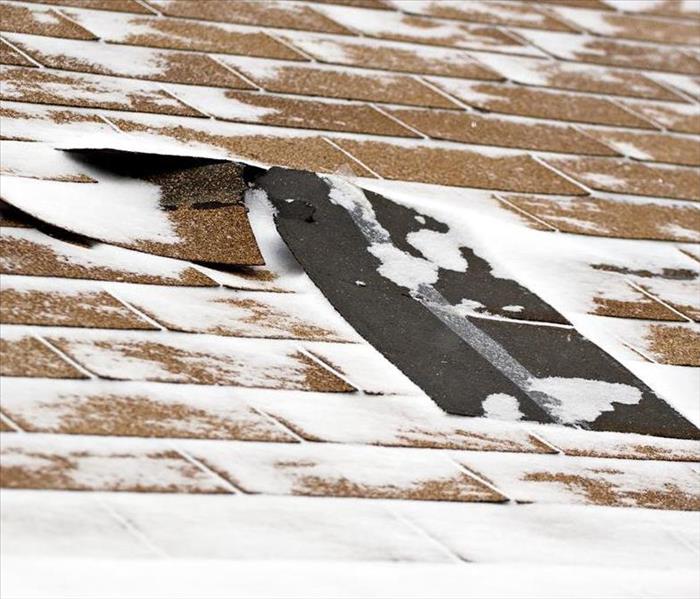 Follow These Tips and Minimize Commercial Winter Storm Damage in your Park City, UT property.
Follow These Tips and Minimize Commercial Winter Storm Damage in your Park City, UT property.
For businesses in Park City, UT, a harsh winter storm is a given, not a maybe. Although Mother Nature may be unpredictable, there are ways to help protect your business from the snow, ice, sleet and wind. Below are five tips to minimize damage and keep your business thriving during harsh conditions.
1. Create a Business Continuity Plan
While storm damage may not be completely unavoidable, developing a business continuity plan helps a business better handle an unwanted disruption. These plans are essential to protect assets and employees while still getting the job done. A plan should include a detailed outline of all business procedures and steps to take when bad weather hits. This should include backup sites to conduct business, team member responsibilities, vendor contact information and a risk assessment.
2. Watch for Weather Warnings
Maintaining a pulse on potential bad weather is essential. Regularly check forecasts to be better prepared for adverse weather coming your way. By doing so, business owners will have more time to make preparations for the impending winter storm. Luckily, there are many apps for smartphones that provide instant updates on any weather warnings or approaching storms. It also may be worth assigning a person to be in charge of this task.
3. Prevent Pipes From Freezing
Winter weather may bring ice and snow to mind, but flooding from a pipe break is also a common concern. If the building's pipes are not insulated, now is the time to call a plumber to make that happen. If cold weather hits, ensure that the building’s temperature doesn’t dip below 55 degrees. Make sure that any outdoor irrigation systems or hoses are drained.
4. Stay on Top of Roof Maintenance
Heavy snow, high winds and ice dams can do a number on your roof. Since its job is to protect your business, it’s vital to stay on top of roof maintenance and repairs. It is ideal to have the roof inspected by a professional annually. Regular checks should also be done after any type of storm. Even a minimal amount of damage may turn into a severe problem when snow piles up.
During inspections, check for any supports that are compromised or missing material. Once snow sits on these areas, it may lead to a leak or collapse. No matter the time of year, never wait to make a roof repair.
5. Get a Generator
Doing business in the modern era often means investing in a significant amount of electronic equipment. From servers to scanners and desktop computers, a power outage means that business comes to a grinding halt. A generator is a smart investment to keep the lights on and the business running as normal. It will also help ensure that the temperature remains above freezing, which will also help reduce the risk of frozen pipes.
As the cold season sets in, a winter wonderland may easily turn into an expensive endeavor if your property sustains damage. By staying on top of maintenance and being prepared, business owners are able to minimize the effects of a winter storm.
How Much Damage Can a Winter Storm Do?
2/23/2022 (Permalink)
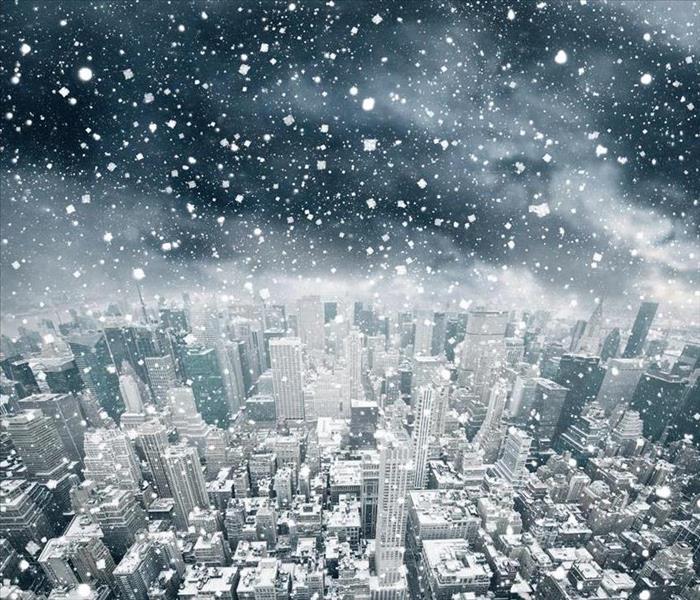 Prevent Storm Damage by following These Tips related to Winter Storms. For more information, just call us.
Prevent Storm Damage by following These Tips related to Winter Storms. For more information, just call us.
Homeowners are usually well aware of the potential hazards of a winter storm; they expect snowfall, ice accumulation, and the potential for slips and falls and car accidents. Still, most remediation specialists in Salt Lake City, UT, also warn of potential structural damage.
While homes in heavy snow climates will usually have the qualities and characteristics that allow them to withstand heavy snow and frigid temperatures, homeowners still need to be aware of their responsibilities to ensure quality home care.
There are several things you want to do to ensure your home is protected from the encroaching winter weather.
- Shovel and salt pathways
- Maintain a clear and clean roof
- Assess seals on all entryways and windows
- Check the HVAC system
Winter Storm Damage and Recovery
A blizzard can be a common winter storm, and it brings with it frigid temperatures and a tremendous amount of snow. While these storms present significant travel threats, they also present risks to your house. The weight of the snow can lead to extensive roof damage; the temperatures can result in cracked windows, and heavy ice might result in power outages.
While there are multiple threats to your property during a winter storm, it is necessary to focus on a quick recovery after the storm. Wintertime is no time to be without power or heat. You should contact a mitigation professional so they can provide a quick response and recovery.
Common Damages During a Winter Storm
Winter storms will often result in roof damage because of snow and ice buildup. Depending on the style of your roof and its integrity, the weight of the snow could cause minor to severe collapses. If the roof is strong enough to hold out, it is possible that it will succumb to water damage.
When ice builds along the edges of a roof, it creates ice dams. As the weather warms, these dams and the snow melt, forcing the water to find alternative exits. Unfortunately, the water will typically back up under the shingles and soak into the sheathing. If enough water makes it to the underlayer of the roof, it could rot the wood or cause mold.
Aside from roof damage, the cold and ice can lead to power outages and window and door damage. Depending on the style of your HVAC system, you could lose heat during a winter storm. If the heat is out for too long, the frigid temperature could cause windows and doors to crack.
Fundamental Recovery From the Storm
After a winter storm, you should assess your property. You want to look for cracks in windows and inspect the thickness of the snow on the roof. You should be careful if you get on a ladder in the snow. The steps can become slick, resulting in falls. It is better to call a remediation professional to the scene. These specialists have the right tools to make professional property assessments.
A severe winter storm is nothing to play around with. You want to remain sheltered during the storm, but you should assess your property afterward to assess potential damage. Contact a remediation company if you need help.
Fire Alarm Basics You Need To Know
2/23/2022 (Permalink)
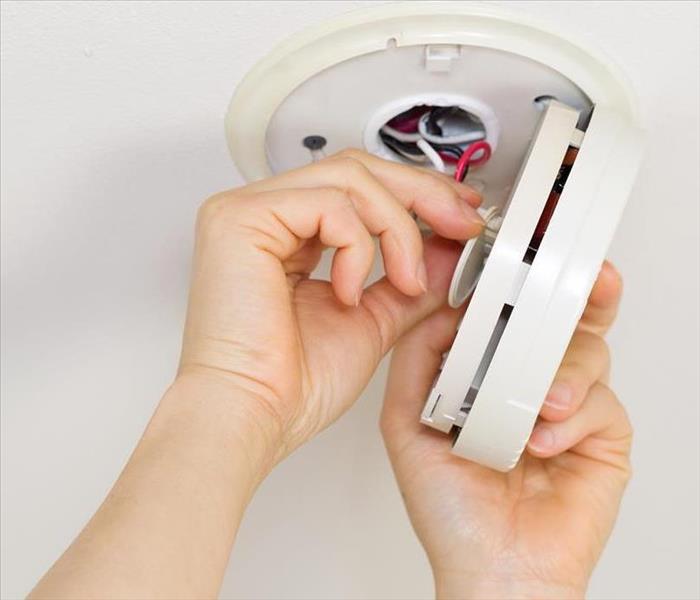 Learn More about Fire Alarms by following These Tips and prevent Fire Damage in your Park City, UT Home.
Learn More about Fire Alarms by following These Tips and prevent Fire Damage in your Park City, UT Home.
The fire alarm is one of the most effective ways to keep your home and family safe from a fire. The more you know about this convenient, affordable tool, the better you can use them in your home. Home fires can be some of the most frightening experiences that impact your home and maintaining a proper prevention and detection system is a vital element of keeping your family safe.
Five Useful Facts and Tips About the Fire Alarm
Which alarms are best? How many should you have in your home? What type of maintenance do alarms require? Installing and maintaining an effective alarm system doesn't have to be difficult, but it does call for some basic information.
1. Smoke alarms have different purposes.
Whether you refer to them as fire or smoke alarms or detectors, it's important to understand the different types and purposes of the alarms. A photoelectric alarm is more likely to recognize a smoldering fire as smoke particles disrupt an internal light sensor. Ionization alarms quickly respond to high flames.
The National Fire Protection Association recommends using both types of alarms in your home or a combination alarm that contains both technologies.
2. You probably need more alarms in your home.
You should have a detector inside each bedroom and in the hallway outside of the bedrooms. You also need a detector on every floor of your home. Consider hanging one in the kitchen, the garage, and other areas of the home where combustible materials are used and stored.
3. Smoke detectors require maintenance and inspections.
You may have already responded to that piercing chirping of an alarm with dying batteries. In addition to the once or twice-yearly battery replacement, you should test each alarm once a month or more often. Look for the test button on your alarm and hold it for a few seconds. You should hear a very loud beep. If you can't hear it or if the alarm is quiet, it's time to replace the batteries.
4. Don't paint the alarm and keep it free from other obstructions.
While you're testing, watch out for dust and buildup on or around the alarm. Paint, dirt, and grease buildup can prevent airflow around the alarm and stop it from detecting flames and smoke.
5. You should invest in interconnected alarms.
Reach out to professionals for an interconnected fire alarm system. If a fire breaks out in one part of the home, you want your entire family to receive the alarm. It only takes a few minutes for fire to spread throughout your home, so every second of advance warning you have gives you a better chance of safely evacuating. When professionals install your system, you can be confident that alarms are connected correctly and in proper working order.
When fire does affect your Park City, UT, home, there's a lot of potential for water and smoke damage, as well as secondary issues. Learn more about the steps you can take to avoid fire damage by reaching out to your insurance company, the local fire department, and fire mitigation and cleanup professionals.
Commercial Fire Damage 101
2/8/2022 (Permalink)
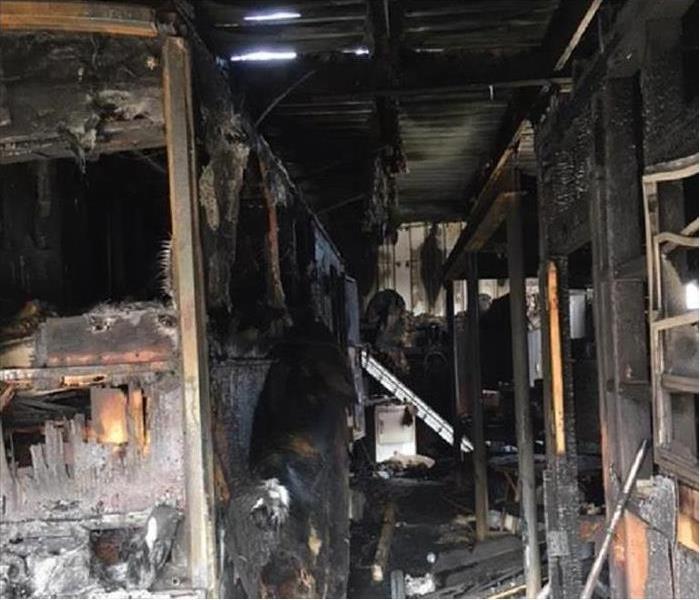 Commercial Fire Damage at a business in Salt Lake City, UT.
Commercial Fire Damage at a business in Salt Lake City, UT.
When your business is on fire in Salt Lake City, UT, you are grateful for every fire truck that responds to your 911 call and every firefighter who holds a fire hose to help put out the blaze. After the last firefighter has coiled up the fire hose and boarded the fire truck to head back to the station, however, you may get your first glimpse of what kinds of fire damage and soot damage with which you are left to cope.
Regardless of whether the fire damage and soot damage was caused by an electrical fire or a utility room fire, it can still be some of the most extensive and complicated commercial fire damage to handle as a business owner. You can get the smoke damage removed and have your fire sprinkler system cleaned and maintained properly to avoid a future electrical fire or utility room fire when you retain the services of a professional commercial fire damage restoration company.
Immediate Response
Despite your best fire suppression efforts to prevent a utility room fire or electrical fire in your business, you still may have to face the possibility of dealing with an extensive commercial fire at some point. Whether the blaze starts because of a faulty fire sprinkler system or simply because your fire suppression tactics were outdated, it can still leave lingering and devastating smoke damage, fire damage, and soot damage in every corner of the building.
As you view the fire damage and soot damage, you might wonder how you can ever get the fire sprinkler system repaired and the rest of your building restored. It all may look like more than you can handle alone.
In fact, the smoke damage as well as water damage from the fire hose and firefighter efforts may be much more than what you are used to coping with by yourself. Rather than tackle such a job unprepared and without the tools you need, you can get the matter dealt with more effectively by retaining a professional fire restoration company.
Fire restoration professionals are trained to respond quickly to and be ready to clean up after an electrical fire, a utility room fire, or any other kind of blaze that impacts your business. After the last firefighter has left and the remaining fire hose rolled up onto the fire truck, the fire restoration contractors can move in and take over the cleanup efforts.
First, they will assess the commercial fire damage that has been inflicted on your building. Based on their findings, they will devise a fire restoration plan that will involve full cleanup of the premises including the inspection and repairs of your fire sprinkler system.
They will use the most modern equipment and cleanup methods to wipe away all signs of water and smoke damage left behind by the firefighter crews. The contractors will also clean up the foam sprayed out by the fire truck, which is commonly used to put out electrical and utility room fires.
Depending on the severity and extensiveness of the commercial fire damage, the contractors may use chemicals like bleach and ammonia as well as gear like shop vacuums and water pumps to dry out and clean up the premises. They also will ensure that the methods they use to clean up and restore the building will be in line with the fire suppression practices that you plan to use to avoid future fires.
You may employ the best fire suppression tactics to keep your building safe. Even so, you still might find yourself the victim of a fire that leaves behind significant damage after it is extinguished.
Because the future of your business relies on how well you deal with the aftermath of a fire, it can be vital that you retain professional fire restoration services rather than try to handle the crisis alone. You can get your business fully restored by entrusting its cleanup to professional contractors.
SERVPRO professionals of Salt Lake City have the specialized fire restoration training needed to restore your home to pre-fire condition.
How To Prepare for Flood Damage
1/25/2022 (Permalink)
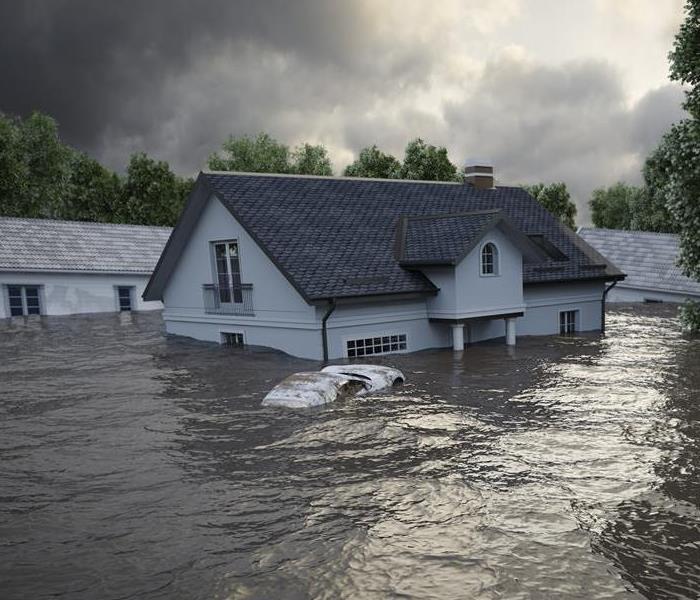 Consider these important tips if you experience Flood Damage in your Salt Lake City, UT property.
Consider these important tips if you experience Flood Damage in your Salt Lake City, UT property.
Damages from flooding exceed $40 billion worldwide every year. You can reduce the chance of suffering extensive flood damage by taking steps to prepare your property.
Tips for Preparing Your Property for Flood Damage
There are several steps you can take throughout the year and when flooding is imminent to help reduce your chance of damage.
1. Purchase Flood Insurance
Most homeowners insurance excludes coverage for damage caused by floods. Because even areas that are not in high-risk zones for floods can experience flash floods, it may be wise to purchase a separate flood policy. However, do not wait until storm damage is imminent to try to buy insurance. There is usually a 30-day waiting period from the time you buy your policy until it goes into effect.
2. Understand Your Flood Risk
Search for your address in Salt Lake City, UT in the Flood Map Service Center to get an idea of how likely you are to experience a flood. It may also be helpful to speak with neighbors who have lived in the area for a long time about how often their property has had flood issues.
3. Complete a Household Inventory
Capture videos and photos of all of your valuable property and store them in a safe place. This will help you if you need to file an insurance claim.
4. Store Important Documents Off-Site
While a water remediation company may be able to save some valuable documents, water damage can easily destroy these fragile items. Store important documents, such as birth certificates, medical records, passports and insurance documents in a watertight safety deposit box.
5. Anchor and Elevate Utilities
Protect important utility equipment, such as propane tanks, electrical panels, wiring, sockets, heating systems and appliances by elevating and anchoring them. You may need to hire a professional contractor to assist you.
6. Make Your Basement Water Resistant
Install a sump pump and water alarm in your basement. Install a backup pump that is battery-operated to protect you when the power goes out.
7. Clean Your Gutters
Debris, such as leaves, sticks and bird nests, in your gutters and downspouts can cause water to pool around your foundation, instead of drain away from your house. Clean out your gutters regularly and before any expected weather event. Consider installing guards on your gutters to keep debris out.
8. Elevate or Relocate Furniture
If you know a flood is imminent, move furniture and other valuable items to the attic or the highest floor in your home. If your home is on a single level, you can elevate your furniture by placing cinder blocks or similar materials under the legs.
9. Monitor Weather Reports and Make a Plan
If a flood becomes bad enough, you may need to evacuate your home. Make a plan for how you will get your family members and pets to a safe place. Use a weather radio to monitor weather reports and sign up for emergency alerts.
There is no way to eliminate your flooding risk. However, these steps can help protect your property, your finances and your loved ones.
6 Indications You Need Professional Pipe Burst Cleanup
1/13/2022 (Permalink)
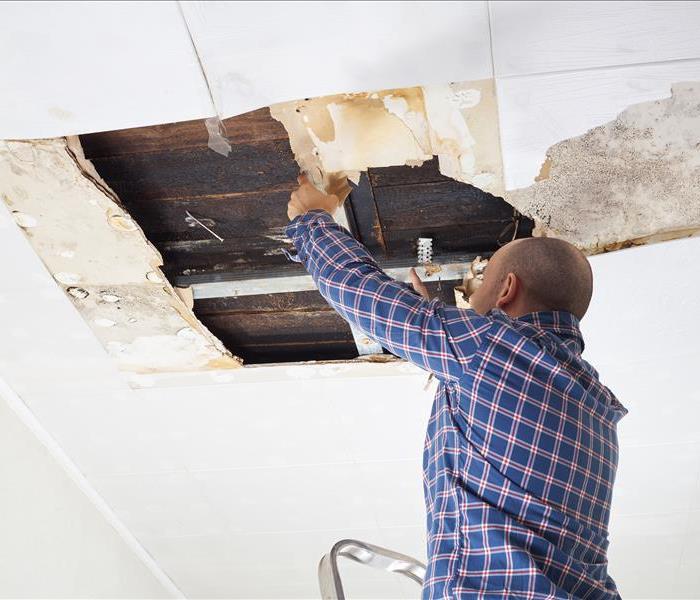 If you find these signs of Pipe Burst in your Park City, UT property, do not hesitate in contact us.
If you find these signs of Pipe Burst in your Park City, UT property, do not hesitate in contact us.
Many property owners avoid hiring restoration professionals unless the property has experienced a disaster such as major flooding or a major fire. Unfortunately, this move can lead to extensive, lasting damage and costly repairs. When pipe burst cleanup is necessary, these property owners may wonder whether it's best to call in a cleanup team or attempt to fix the problem on their own. How can you tell when it's okay to address property damage on your own and when it's necessary to call a restoration company?
Signs You Need a Professional Response for Pipe Burst Cleanup
It doesn't take long for water to cause a lot of damage, and you need to act quickly to prevent that from happening. You need to know when to contact professionals before a broken pipe or sound of running water happens. If your situation includes any of the following elements, you should act quickly to contact a water and sewer cleanup company:
1. Indications of Damage
You may not realize that there's trouble brewing for your Park City, UT property. There are several signs that damage is taking place even though there wasn't an immediate cause of trouble:
- Increase in utility bills
- Flaking or bubbling paint
- Water spots
- Musty, moldy smells
- Pools of water
2. Electrical Complications
If there is any chance that water has come into contact with wiring, outlets, or any other source of electricity, you should clear the area and contact professionals. When you consider the fact that touching an appliance with damp hands can cause a powerful electric shock, the risk of electrocution during flooding becomes more powerful.
3. Unseen Damage
When water spills from an overflowing toilet or gushes from a broken pipe, there is immediate and obvious damage on the surface. Unfortunately, moisture often seeps underneath the flooring, behind drywall, and into other spaces that are out of sight.
Without professional equipment, it is very hard to measure how widespread the unseen damage has become. If pockets of humidity are untreated, mold and deterioration will continue to spread and cause more expensive damage.
4. Exposure to Contaminants
Water from the sewer system is often "black" water, meaning that the water contains feces, chemicals, and other contaminants. Even water that was clean when it first burst from pipes may pick up chemicals as it rushes past insulation, rodent droppings, and household cleansers. This type of exposure can become dangerous during pipe burst cleanup and should be left to professionals with the right protective gear.
5. Need for Quick Resolution
Many property owners can't afford to shut down their property for drawn-out repairs and restoration. Whether you can't sacrifice manpower to clean up or you're concerned about shutting down your operations for days or weeks at a time, a professional response is best. Technicians have the time, supplies, and other resources to thoroughly and efficiently return your property to its original condition.
6. Equipment To Save
Water affects appliances, furnishings, and other belongings in a variety of ways. Professionals can help you decide what can be cleaned and salvaged after flooding. Recovery from flooding, pipe burst cleanup, and remediation from a slow, seeping leak doesn’t always require a professional response. However, when you want a full, satisfactory recovery, the best tactic is to bring in trained technicians
The Steps of the Fire Restoration Process
1/7/2022 (Permalink)
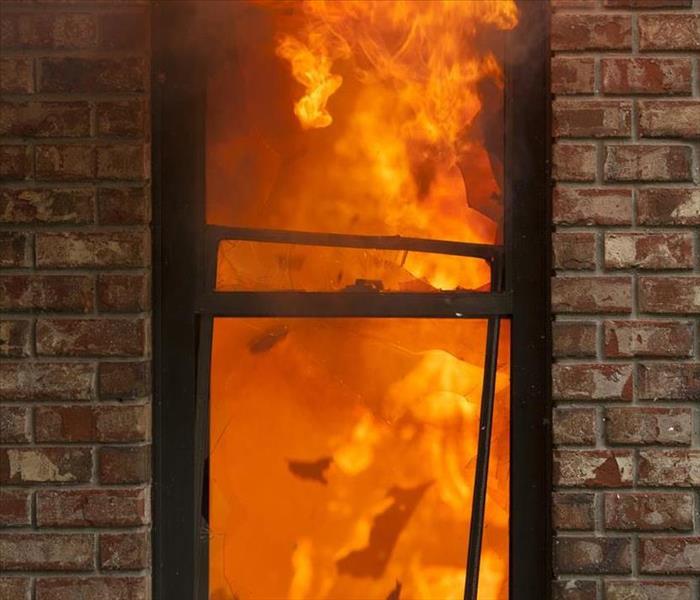 Check these important Steps to Restore your Salt Lake City, UT house after a Fire.
Check these important Steps to Restore your Salt Lake City, UT house after a Fire.
A fire in your home in Salt Lake City, UT, can cause a lot of damage. Additionally, while the water used to put out the fire may save the structure, it can also saturate and ruin porous materials. The fire restoration process involves not only mitigating all this damage but also rebuilding your home so that it looks like it did before the fire. There are several steps in this process.
Follow these Steps to Restore your house after a Fire.
1. Assessment
The first thing that fire damage remediation specialists do when they arrive is to survey the damage to your home. This assessment reveals several factors that must be addressed in the mitigation process:
- Extent of the water and smoke damage
- Areas vulnerable to egress
- Equipment needed to resolve issues
Once they have this information, the technicians can formulate a plan for remediation and repair. They may also be able to give you a general estimate of the cost at this point.
2. Security
A fire typically causes windows to break and makes holes in the external structure of your building. Before work begins, the mitigation team boards up vulnerable spots to keep invaders such as animals, vandals and thieves out of your home.
3. Extraction
Standing water and damp materials can make any existing damage worse the longer they remain in your home. Therefore, technicians use industrial pumps to quickly extract water out of the way to minimize secondary issues.
4. Removal
The next step in the fire restoration process is the removal of any materials that are damaged beyond repair. Technicians tear out saturated drywall and insulation. They may also remove carpet, tile and ceiling materials. They also take furniture and other belongings out of the affected area so that they can be cleaned or discarded.
5. Cleaning
Damage cleaning is necessary for the removal of any dirt, soot or bacteria on the remaining surfaces. The space is likely contaminated and thus must go through a disinfection process. This gives the team a clean slate to work with before rebuilding begins.
6. Drying
Before adding new materials to the structure, the mitigation team wants to ensure that the space is dry. This prevents further damage such as mold growth. All surfaces are dried, and the humidity level in the space must be an acceptable level before they can proceed.
7. Restoration
The final stage is rebuilding the structure of your home and making it livable again. The restoration team adds new insulation and replaces the walls, ceilings and floors that were taken out. Then they make sure that the new parts match the remaining structure to provide a seamless view. When the whole project is finished, you shouldn't be able to tell where the damage happened.
A lot of damage can occur when fire ravages your home. The fire restoration process includes not only dealing with the effects of the actual fire but also removing water and drying out the area so that no further problems occur. Understanding everything that goes on during cleanup is important so that you have a realistic timeline for when your home is ready for your family again.
Business Claims: Making a Disaster Claim
12/9/2021 (Permalink)
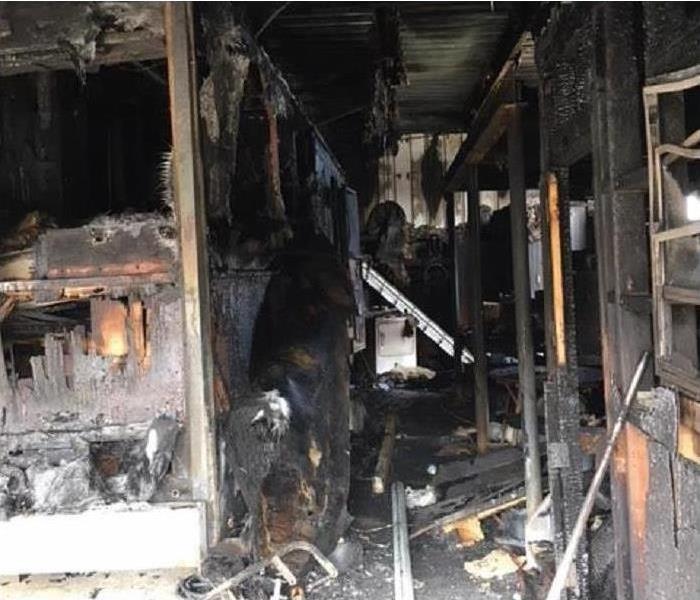 Fire damage in Park City, UT.
Fire damage in Park City, UT.
Fire Claim Process
While a blaze burning through your facility and your inventory is devastating enough, the fire damage can leave your property and your business boarded up for months. This is why it is essential to start the fire claim process immediately so that you can minimize the extent of the business interruption and get back to work quickly.
1. Call Your Insurer
While the first calls you make are to emergency services and family, the third call you should make after a fire is to your insurer. You want to make this call immediately after a fire to ensure that the claims process is initiated at the earliest possible moment. The longer you wait to make a claim, the longer it will take to get your business up and running.
2. Mitigate Further Damage and Loss
After you initiate the fire claim, you will want to get a fire restoration specialist from the Park City, UT, area on the scene to board up and tarp your facility, mitigating further damage and loss. If you already have a plan in place with a restoration expert, then call them and get the process started. Keep in mind that your insurer may require you to mitigate further loss, meaning that if you don’t, then your coverage may not kick in.
3. Keep Receipts
As you begin the cleanup, be sure to track all of your expenses by saving and tallying all receipts. When the adjuster arrives, they will want a full record of the damages incurred and the mitigation efforts made to reduce further property loss and damage.
4. Make a Record of Loss
Additionally, you should walk your property, photographing all damages to show your insurance adjuster. This record of loss will be used when evaluating your claim. You should also include any relevant receipts for the damaged property so your insurer can create an accurate valuation of the overall loss.
A fire claim may seem like a confusing process, but as with every bureaucratic process, there are appropriate steps to take. After a fire, just make sure to call your insurer, mitigate further damage, keep receipts and make a record of loss.
How To Repair a Leaking Faucet
11/24/2021 (Permalink)
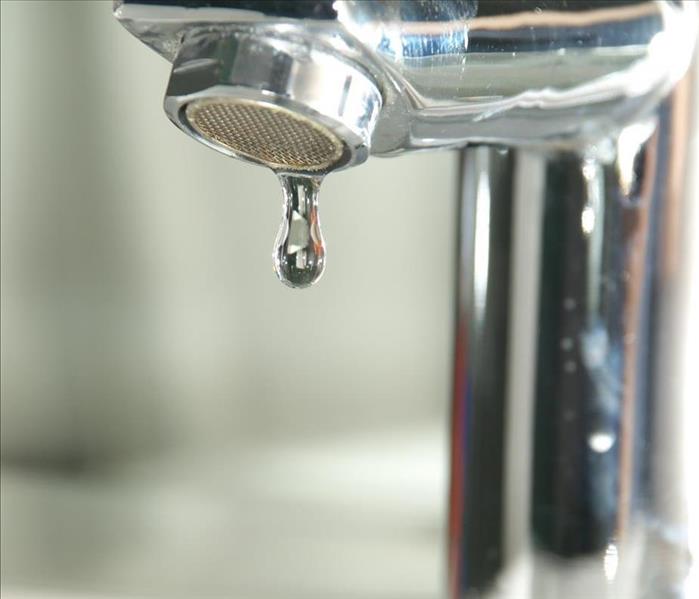 A leaking faucet can lead to water and mold damage in your Salt Lake City, UT home.
A leaking faucet can lead to water and mold damage in your Salt Lake City, UT home.
When your home is quiet and you suddenly hear the quiet sound of a leaking faucet, it's often the prelude to another home maintenance chore. Don't postpone this repair, though; that little drip can add up to gallons of wasted water and an increased Salt Lake City, UT, water bill.
5 Steps of Leaking Faucet Repair
Here are the steps you can take to fix the leak before contacting a water and mold cleanup and repair crew to address any damage:
1. Turn Off the Water
Start by looking underneath the sink. There should be pipes running along the wall with a handle for shutting off the water. Turn the handle clockwise. Once you believe the water is off, turn the faucet on in the sink to be sure. Next, plug the sink to prevent losing any hardware down the drain.
2. Determine the Type of Faucet
There are four common types of faucets: compression, ball, cartridge, and ceramic disk. The compression faucet has separate handles for hot and cold water, so it is easy to identify. You may need to disassemble the faucet to determine the other types of mechanisms. The ball faucet has a ball bearing inside the faucet. The cartridge and ceramic disk faucets have, respectively, a cartridge and ceramic disk within the faucet.
3. Gather Your Tools
Before you start taking the faucet apart, gather the supplies you'll need. These include a bucket, some towels, and rags, an Allen wrench, an adjustable wrench, some needle nose pliers, slip joint pliers, and both flathead and Phillips screwdrivers. You will probably also need a faucet repair kit and some fresh O-ring seals. Make sure you have an area to lay the parts of the faucet, so they don't get lost.
4. Identify the Source of the Leak
Once you have taken the dripping faucet apart, look for a dried-out or worn rubber washer, a piece of broken hardware, or gaps between mechanisms. The specific steps for repairing or replacing parts vary by type of faucet. For example, repairs to a cartridge faucet often involve cutting out old O-rings and using a plumber's grease when installing new rings. In a compression faucet, you can generally pull the washer out; however, you do need to have the exact match for a good repair. You can usually find the specifics for your leaking faucet online or at your local hardware store.
5. Reassemble the Faucet
After you've replaced the damaged components, put the faucet back together. If you're not sure, refer to the instructions on the repair kit or use an online how-to video. Don't put your supplies away, however, until you have tested the faucet. There shouldn't be any drips from the faucet after a successfully fixed leak.
Contact Professionals To Prevent Mold
After completing your leaking faucet repair, it's important to contact mold and water damage professionals. It doesn't take long for a small amount of hidden moisture to develop into a thriving mold colony. You may not spot any mold right now, but when you can see or smell it, the problem has already become significant. Remember that prevention and quick action is the best way to limit the expense of mold remediation.
Use Containment Methods To Prevent Cross-Contamination During Mold Remediation
11/11/2021 (Permalink)
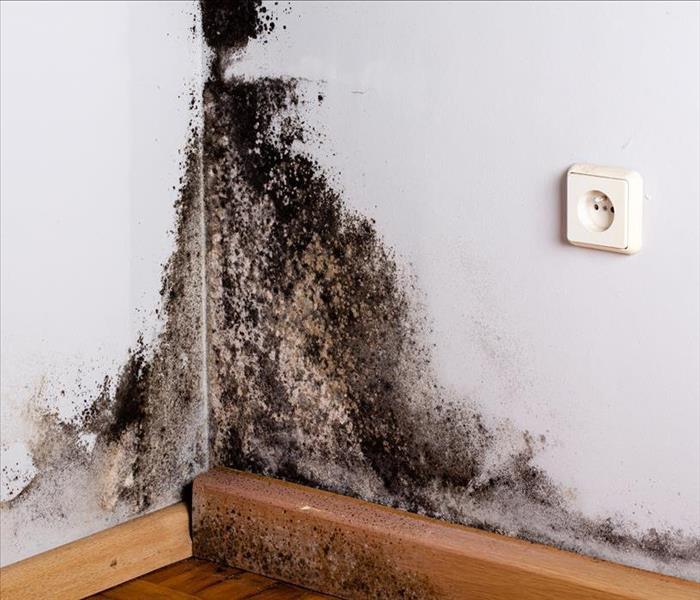 Clean mold as soon as possible to get it under control and avoid further damage in your Salt Lake City, UT commercial building.
Clean mold as soon as possible to get it under control and avoid further damage in your Salt Lake City, UT commercial building.
A safe mold cleanup job at your Salt Lake City, UT commercial building begins with installing the proper means of containment. This step is fundamental in ensuring that the mold spores from the affected area are not carried into unaffected regions of the building (i.e., cross-contamination). If you opt to tackle the job yourself, it's vital to know the proper containment measures to use for your specific issue. Your best bet is to hire reputable, certified mold remediation professionals to perform the work because they have the expertise and industrial-grade equipment to handle it appropriately and with the most safety. In addition to containment, the restoration team should use other equipment such as air scrubbers to help purify the air throughout the cleaning process.
4 Types of Containment Methods Used for Mold Remediation
Depending on what type of mold contamination you have at your office and its severity, there are various options for containment.
One or a combination of multiple types of containment may work best for your specific situation, such as:
Create a Negative Air Chamber
A negative air chamber utilizes ventilation systems to create airflow in the affected area without allowing the air to escape the room. The air and its tiny particulates are prevented from traveling through the ventilation system. Therefore, the spores are contained in the negative air chamber, narrowing the problem to a single location.
Perform a General Cleanup
Isolation isn't limited to just containing an area and its contents. Discarding unsalvageable damaged items is also a very effective mold cleanup method. Tear out water-damaged porous materials, such as drywall, carpeting, and baseboards. Then, carefully place the destroyed materials in thick trash bags and seal them securely. You should take these bags outside immediately.
Seal the Work Area With Plastic Sheeting
Thick plastic sheets can create a barrier between the contaminated area and the rest of the building. This isn't the most dependable way of preventing cross-contamination. Therefore, it's best to combine it with at least one other containment system. It's also essential to restrict traffic to the affected area to remediation workers only, if possible.
Install High-Efficiency Particulate Air Filters
Some air filters are made specifically for capturing mold spores and other tiny air particulates. These filters are very beneficial for isolating the problem by catching the spores before they have a chance to grow and reproduce. Filters, such as the HEPA variety, must be extremely fine so they can capture spores and other tiny particles from the air. It's best to look for products recommended by mold experts to ensure you get the best result while resolving your issue.
When you discover a mold contamination problem at your workplace, you need to immediately take action to get it under control. The issue will only get more severe with time, and it can get out of hand quicker than you may realize. Whether you are doing the mold cleanup job yourself or hiring experts to do it, it's helpful to know about the various containment procedures. Understanding the details of these kinds of problems before you are personally affected by them can help you if you ever experience such an issue.
6 Steps To Take After a Basement Flood
11/11/2021 (Permalink)
 Call us to help you to deal with your basement flooded and minimize the damage.
Call us to help you to deal with your basement flooded and minimize the damage.
Heavy rains or overflowing streams and rivers can lead to a basement flood. If this happens to you, it is important to take steps to minimize the damage.
6 Things To Do When You Have a Flooded Basement
Mold can begin to grow in 24 to 48 hours, so quick action is needed to prevent additional damage. SERVPRO professionals are Faster to Any Size Disaster. A SERVPRO franchise in Salt Lake City, UT, can help you get your basement dried out before mold becomes a problem.
1. Remove the Water
If you only have a few inches of water in your basement, you can probably extract it with a wet vac. A more significant basement flood may require professional equipment. You may be able to rent submersible pumps, but if your flooding is the result of a large storm, chances are everyone else is trying to get ahold of this equipment also and it may be hard to come by. Consider contacting a water remediation company instead.
2. Dry Your Basement
Once you have the water out, you need to quickly dry your basement and its contents to avoid the potential for mold growth. Dehumidifiers and fans can help circulate and dry the air. Running your air conditioner may also help. Remove wet contents and discard or allow to dry outside.
3. Clean the Floor
Floodwater can leave dirt, silt and contaminants behind. Clean your basement floor with a solution of one cup of chlorine bleach mixed with one gallon of water. Wear protective eyewear and rubber gloves and make sure you open doors and windows for ventilation.
4. Freeze Documents
Your basement isn't the best place to store valuable documents because of the flood risk, but if you have papers that got wet, put them in the freezer. This may prevent mildew from growing and keep the documents from deteriorating until you can take them to a professional for restoration. Prevent future problems by moving valuable possessions out of your basement and putting anything you store in there in plastic bins on concrete blocks, instead of cardboard boxes on the floor.
5. Inspect and Clean Gutters, Drains, and Downspouts
Clear any twigs, leaves, or mud from your basement drains. Remove the drain screen and clean it. If the drain is clogged, use a plunger or plumber's snake to unclog it. Clean your gutters and downspouts and make sure they are pointed away from the foundation of your home.
6. Call Your Insurance Company
Most homeowners' policies have an exclusion for flood damage, but if you purchased a separate flood insurance policy, you may have insurance coverage. Talk to your insurance agent or call the claims center to file a claim. If the water in your basement is from a broken pipe or supply line, the water damage may be covered as a sudden and accidental discharge of water.
A basement flood can be a hassle to deal with. However, if you have a plan in place, you can systematically work through the problem until it is resolved while minimizing the amount of damage to your home.
Flood Safety Tips for Homeowners
10/19/2021 (Permalink)
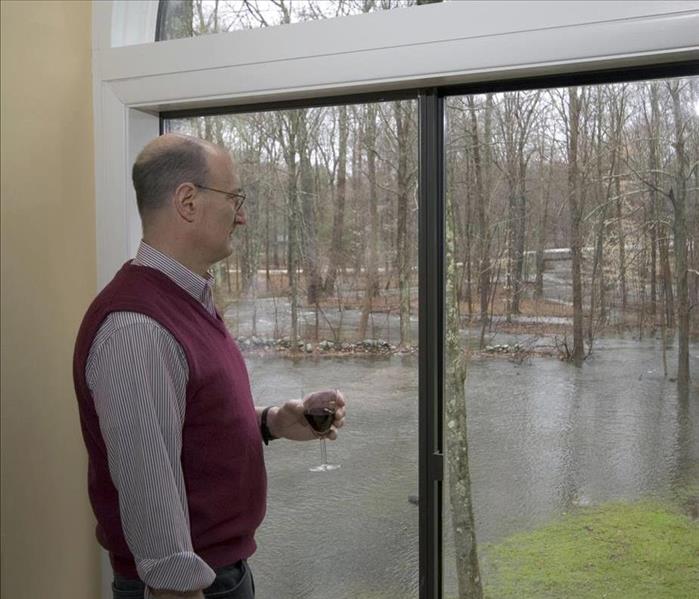 Taking some preventions will reduce the storm damage to your Salt Lake City, UT home.
Taking some preventions will reduce the storm damage to your Salt Lake City, UT home.
Storm season in Salt Lake City, UT, brings several possible challenges to homeowners. One of the main concerns is flood safety. You can't control the weather, but you can take some precautions.
Tips To Protect Your House.
Elevate Items for Flood Safety
Electricity and water don't mix. One of the most sensible safety tips starts with identifying the flood line. Once you know how far water is likely to rise, you can more easily safeguard the electrical items both inside and outside your home:
- Sockets
- Wiring
- Circuit breakers
- Air conditioner units
- Generators
These and other electrical appliances should be placed a foot above the flood line if possible. It also doesn't hurt to elevate the things in your basement that are likely to become a hazard if they get wet. By keeping electrical items out of the way of potential floods, you can minimize a lot of damage.
Maintain Sewer To Prevent Blockages
Regular sewer maintenance is always important, but it's especially crucial during storm season. Excess flooding from a heavy downpour can overtax municipal drains, causing a backup. If your home already has sewer problems, this can lead to some unpleasant results in your bathroom or kitchen.
One way to protect your home from a flooded city sewer is to install valves to prevent backflow. Check or flap valves provide a one-way seal that keeps wastewater flowing outward. Manually operated gate valves provide even better protection. No matter what kind of valve you choose, you need one at every point where your plumbing connects to the sewer line.
Maximize Water Flow Away From Home
The best way to ensure flood safety is to keep the water from coming toward your house in the first place. Flood restoration specialists recommend that you upgrade your landscaping to slope away from your house so that pooling water doesn't encroach on it during a heavier storm. Keep drains, downspouts, and gutters clean so that water flows easily off your roof and away from your foundation.
Sometimes water rushes toward your house because it floods the street and simply has nowhere else to go. If this happens, contact your county department that is in charge of street maintenance to report the problem and inquire about what can be done to fix it. After all, if it affects your house, it probably is a nuisance to your neighbors as well.
Protect Your Foundation from Flooding
Floodwater will seep into cracks in your foundation any chance it gets. This is one of the reasons it's so important to inspect your foundation and repair any damage found as soon as possible. You can also install valves that direct the flow of water through designated paths through the building so that it doesn't rise and cause damage.
Placing barriers around entryways and the perimeter of your foundation is another way to flood-proof your home when a storm is on its way. Sandbags and inflatable barriers can be used to block extra water.
Knowing how to protect your home from flooding empowers you as a homeowner. Follow these flood safety tips to prevent as much damage as possible during a storm.
How Is Content Cleaning Done After a Fire?
10/14/2021 (Permalink)
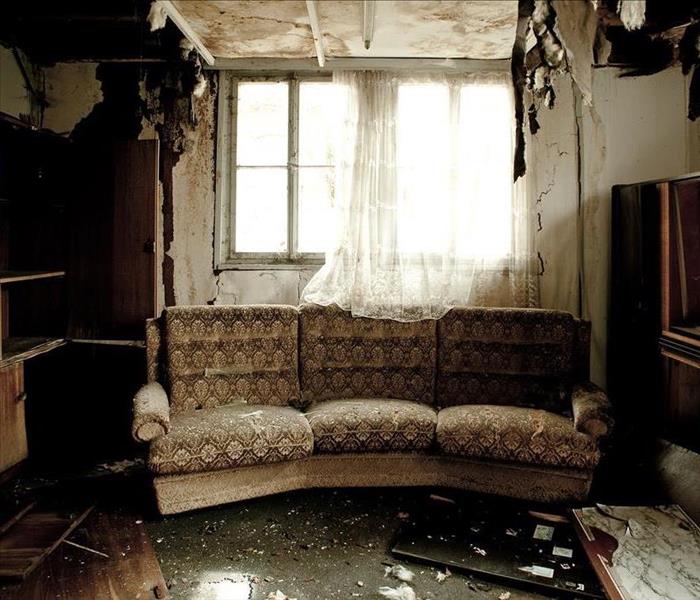 After a fire in your Salt Lake City, UT home, some damaged items can be restored.
After a fire in your Salt Lake City, UT home, some damaged items can be restored.
Whenever a fire occurs in a home there is damage from the heat and flames, smoke and soot, and the water or chemicals used to put out the fire. Some contents may be destroyed; however, some contents can be restored by using one or more cleaning methods, such as dry-cleaning.
5 Content Cleaning Steps for Fire Damaged Items
Restoring fire-damaged contents can be a difficult process. Smoke and soot stains and odors can linger for years if the correct cleaning techniques are not employed. For many homeowners, it is a good idea to contact a fire restoration company in Salt Lake City, UT, to clean fire-damaged contents. Most restoration companies employ a five-step cleaning process.
1. Take Precautions for Safety
Entering a fire-damaged structure can be dangerous. Restoration professionals take steps to make sure anyone entering the structure during cleanup is safe. To protect workers against smoke and soot particles in the air, respirators are worn. Gloves and other protective clothing protect against contact with soot on surfaces. Workers ensure that there is enough ventilation to keep working conditions safe.
2. Assess the Damage
Next, restoration professionals examine the damaged contents and decide which can be cleaned, which should be placed in content storage and which should be thrown out. They consider the value of the property when making this determination. It is important that this step be completed quickly because the longer soot remains on items, the more damage it can cause. Many items that have not suffered direct damage from fire or heat can be salvaged. Textiles, such as bedding and draperies, can usually be restored by dry-cleaning. Open food items are thrown away. Unopened food may be safe, but if there is any question it should be discarded. Plastic that is melted or discolored can be cleaned, but not restored.
3. Take an Inventory
If anything needs to be cleaned off-site, the restoration company will record which items are removed, where the items are stored, and what condition the items were in when taken out. For insurance purposes, an inventory is also made of any items that are discarded.
4. Perform Content Cleaning
The restoration company will then determine which cleaning method is best for each item and begin the cleaning process. Dry or wet cleaning is usually done for items with light residues. Spray and wipe methods are used for items that can not be wet cleaned without damage. Foam cleaning is often used for upholstery fabrics that may shrink or discolor if wet cleaned. Abrasive cleaning is only done on items that can withstand surface agitation. Immersion cleaning involves dipping items into the cleaning product.
5. Remove Odors
Finally, after cleaning is complete, the restoration company will remove smoke odors. Smoke odor removal may be done by ozone or hydroxyl deodorizing.
Whether you have lightly damaged items that need dry-cleaning or heavily damaged contents that require other techniques, a restoration company can salvage many items damaged by smoke or soot. However, it is important to act quickly before contents become damaged beyond repair.
Black Mold and Secondary Water Damage
10/6/2021 (Permalink)
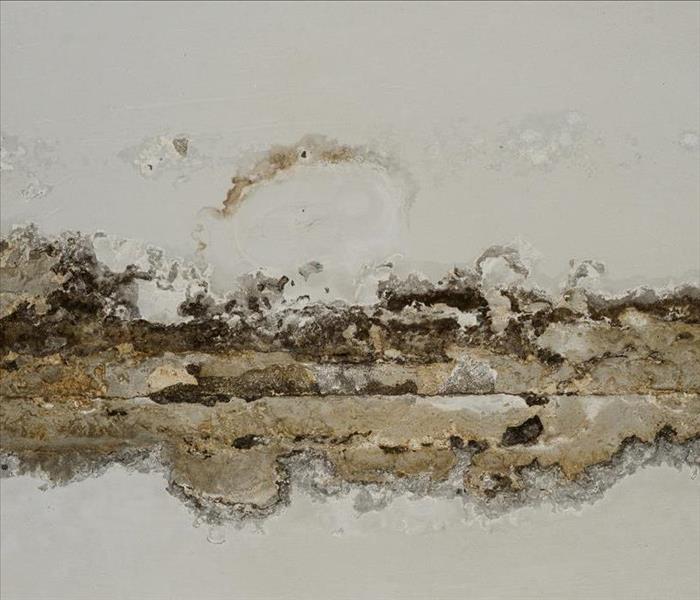 Water damage in your Park City, UT building leads to black mold and further damage.
Water damage in your Park City, UT building leads to black mold and further damage.
An emergency pipe burst or trouble along the sewer line can quickly put the brakes on your daily operations. Your quick efforts to deal with the source of trouble, to remove the water, and to thoroughly dry your facility can prevent a lot of further problems. Unfortunately, it is possible for water to soak into carpeting or drywall and for humidity to build-up, allowing for the growth of black mold and other forms of mildew.
Dealing With Black Mold and Other Damage
The first step in tackling secondary damage from any type of water leak or flooding is understanding the problem. Learn as much as you can about the types of damage you can expect:
- Mold growth
- Rotting materials
- Peeling vinyl and paint
- Warped wood
- Compromised electrical wiring
- Corrosion and rust
As you come to fully understand the havoc caused by hidden pockets of moisture and high humidity, you're better prepared to aggressively target those problem areas.
Understanding the Causes of Further Damage
One of the main reasons properties suffer from black mold and other forms of damage are that flooding, leaks, or spills weren't properly mitigated the first time around. Certified cleanup and mitigation professionals are trained to prevent secondary harm, protect your building from lasting damage, and save you a lot of money in ongoing repair costs.
As a property owner, you may be a fastidious cleaner with a determination to properly repair and clean your facility. However, there are several areas where moisture builds without giving notice of the trouble brewing:
- Humidity buildup in the air conditioner
- Damaged appliances with hidden leaks
- Hidden moisture beneath or behind surfaces
It isn't uncommon for property owners to thoroughly clean and dry their buildings, only to discover later on that damage, such as mold growth
Taking Action Immediately
It doesn't take long for water to cause a lot of expensive damage. It is vital that you act immediately for the protection of your building. This means shutting off the main source of water, contacting cleanup crews right away, and getting all available hands involved in the cleanup. If it's possible to remove carpets from the floor, you may prevent an expensive loss of flooring.
Avoiding Secondary Problems
In addition to hiring professionals to help you recover from water damage, there are steps you can take to prevent further trouble. Once you've dealt with the immediate flow of water, open doors and windows to provide thorough ventilation. Remove water and water-logged furniture, equipment, and belongings as quickly as possible. If it's safe to use the electricity in your building, set up fans in the affected area. Be sure that there's a consistent flow of air through unaffected rooms so that humidity doesn't build up and cause new damage.
For the best results, choose a Park City, UT, professional company to deal with water damage before your experience any type of trouble. This proactive step ensures that you or your employees know who to call, so professionals arrive as soon as possible. The better you understand black mold and other secondary harm, the better able you'll be to take prompt action and avoid a lot of expensive damage.
Reasons To Make SERVPRO a Preferred Vendor
9/28/2021 (Permalink)
 If you see water damage in your Park City, UT home, contact your insurance agency to get help.
If you see water damage in your Park City, UT home, contact your insurance agency to get help.
Few things can cause as much damage to your clients' homes in as little time as excess water. They need a restoration team they can depend on to be there quickly to start the cleanup process as soon as possible. The water damage mitigation experts at SERVPRO in Park City, UT, are ready to provide fast, 24-hour response, seven days a week, and this is one of the many reasons that SERVPRO is a preferred vendor for many insurance agencies.
Damage Timeline
Water doesn't waste any time destroying a structure. A lot can happen to a flooded home within the first 24 hours:
- Saturated walls start to bow and deteriorate
- Insulation is ruined
- Hardwood floors start to buckle
- Carpets are stained by furniture or other items that bleed onto them
- Mold begins to grow
- Wood furniture starts to swell and splinter
- Documents and keepsakes are drenched
With each hour, the damage gets worse. Your clients need a team known for its fast response time so that no matter how much water gushes into their homes, the destruction is kept to a minimum.
Quick Attention
With a 24-hour call center ready to mobilize the local team any time of the day or night, SERVPRO outshines the competition. Technicians are alerted and respond to the first notice within an hour of the call. Within four hours, the team is on-site at your client's home, assessing the problem and detailing what needs to be done to fix it. The lead specialist is ready to confer with your clients to outline what the cleanup process is going to look like and give them an estimate of the cost within eight hours of the initial contact.
Thorough Restoration
Because SERVPRO is always open, the technicians can get right to work after the assessment is complete. They start by extracting all the excess water with industrial pumps and other drying techniques. Then they tear out damp insulation, waterlogged drywall, and ruined carpets that can't be salvaged.
Once the parts of your clients' home that the flood destroyed are removed, the specialists repair what's left. If the water was contaminated, they disinfect the affected area to remove any bacteria or other microbes present. Then they make sure that every part of the remaining structure is dry to prevent secondary damage such as mold or mildew.
The final step is restoration. Your clients are unlikely to be satisfied unless the house looks the same way it did before the water damage occurred. The team rebuilds the structure and matches the walls, ceiling, and flooring with the elements that remain for a seamless finish. When you partner with SERVPRO, you can rest assured that your clients are getting the best and most thorough service on the market.
With 24-hour service and a commitment to quick response times, it is no wonder that many insurance providers choose SERVPRO as a preferred vendor for their clients. A team of certified, experienced specialists can be on-site within hours of receiving the first call, and they do not stop until your client's home is completely restored.
How Do I Make a Water Damage Insurance Claim?
9/16/2021 (Permalink)
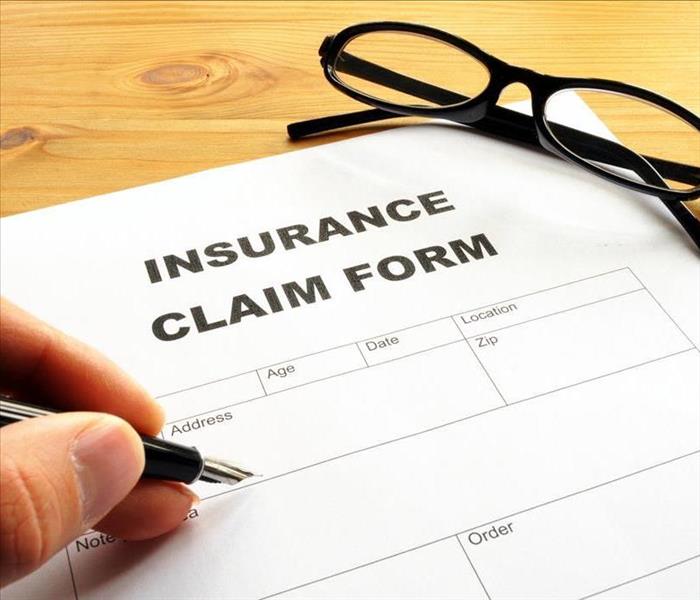 Filing an insurance claim form correctly is essential to get your Park City, UT home restored faster.
Filing an insurance claim form correctly is essential to get your Park City, UT home restored faster.
Water damage is one of the most common reasons homeowners file an insurance claim. To get your claim processed quickly, it is helpful to familiarize yourself with the claims process before you need to make a claim.
How To File a Homeowner's Claim
Filing a homeowner's claim is a multi-step process. Proceeding through the steps in order will help you make sure you don't forget to do anything.
1. Read Your Policy
Your policy should explain what your responsibilities are and what types of damage are covered by your policy. This is particularly important for water damage claims, because most homeowner's policies cover water damage from sudden and accidental discharges, such as a pipe burst, but exclude damage from a flood.
2. Mitigate Your Damage
Most insurance policies require homeowners to mitigate their damages. This means that if there are reasonable steps you can take to prevent additional damage from occurring while you are waiting to get the initial damage repaired, you are expected to take those steps. An example is shutting off the water to your home when you have a leaking pipe. If you have to spend any money to make temporary repairs, save your receipts. Your insurance policy may cover these costs.
3. Contact Your Insurance Company
Call your insurance agent or the claims office of your insurance company as soon as possible to begin the process of filing your insurance claim. Ask any questions you have about your coverage and deductible. Find out how long it will be before repairs can begin. Ask if you need to get an estimate done or if the insurance company will be sending someone out. Drying your property out promptly is important, so you may want to inquire about hiring a water remediation company in Park City, UT, to begin that process.
4. Complete Claim Forms and Other Paperwork
Your insurance company may mail your forms or allow you to complete them online. It may also ask you to submit other documentation. Return the requested materials as soon as possible. The longer you take to furnish the requested documentation, the longer it will take to process your claim.
5. Prepare for the Insurance Adjuster
In most cases, your insurance company will send an insurance adjuster to inspect your home and estimate the amount of damage. Take photographs of your damaged property and make an inventory of everything that was damaged. Gather together any receipts or other documentation that proves the value of your damaged property.
6. Keep Your Receipts for Relocation Expenses
If your home is uninhabitable because of the damage, keep your receipts for the cost of hotel rooms or rent for the period of time you are unable to live in your home. You may also be reimbursed for other additional living expenses, so keep the receipts for anything you had to spend money on because you were unable to occupy your home.
Filing an insurance claim for water damage can sometimes be confusing, but your insurance professional should be able to answer any questions that you have. Promptly and correctly filing your claim is critical for getting your home restored as quickly as possible.
Is Fungus Cleanup Covered by Your Commercial Insurance?
9/8/2021 (Permalink)
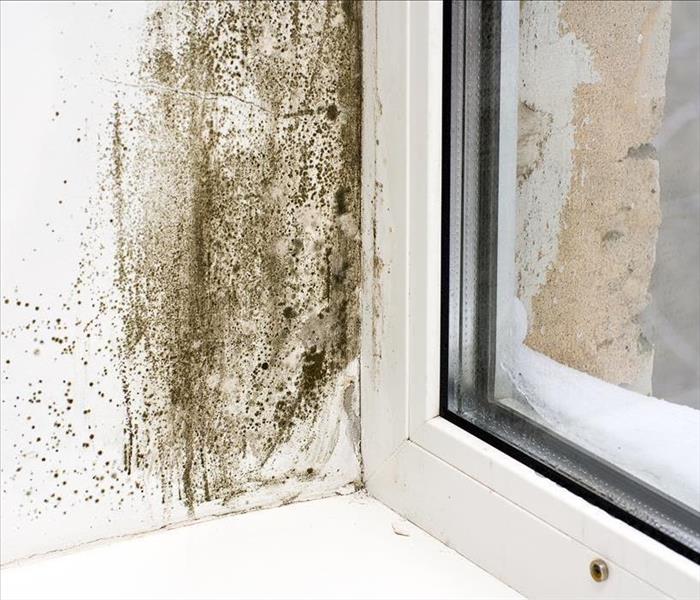 The mold cleanup will not be covered by the insurance if it is a negligence case in your Salt Lake City, UT commercial property.
The mold cleanup will not be covered by the insurance if it is a negligence case in your Salt Lake City, UT commercial property.
It doesn't take much time for a water disaster to transform your commercial property from normal daily functioning to impossible to operate. Unfortunately, leaky pipes, storm damage, and backed-up toilets cause much more than an immediate inconvenience. High levels of humidity or a small puddle of water that soaks, unnoticed, into the carpeting can create the perfect environment for mold growth. The good news is that your commercial insurance provides coverage under most circumstances. The bad news is that many policies have a significant exclusion for losses or damage caused by fungus.
Understanding the Fungus Exclusion in Your Commercial Insurance Policy
Many commercial insurance policies have exclusions related to the pollution, fungi, and bacteria present in Category 3 water. If this exclusion is present in your insurance policy, you may have a coverage gap.
What Is Fungus?
Fungus and fungi are broad terms used in the insurance industry to describe many contaminants:
- Mold
- Mildew
- Mushrooms
- Spores
- Toxins
- Yeasts
- Any by-products left by any type of fungus
The fungus exclusion means that damage such as dry rot, bad smells caused by the presence of fungi, and the spread of fungus throughout your Salt Lake City, UT, property doesn't fall under your standard commercial property insurance coverage.
Why Isn't Fungus Covered?
Mold damage is generally covered if it happens because of "a common peril." These situations may include a pipe break or some overflow from your malfunctioning air conditioner, for example. This type of damage is covered because it was caused by the sudden presence of water.
Damage is not covered when the insurance company can show that negligence or flooding was the culprit. If, for example, a fixture under a bathroom sink has been seeping water for several years, the resulting mold growth won't be covered. If certain rooms on your property are consistently humid and you haven't used a dehumidifier, your policy may not cover the resulting damage. These are examples of negligence.
If heavy storms lead to flooding and water from that storm travels across the ground before moving through your property, causing mold growth, the damage probably won't be covered unless you have a specific flood or mold insurance policy.
Is There a Solution?
Some insurance providers offer Limited Fungus Coverage. This policy has many limitations. There is often an amount limit tied to one occurrence in your policy year. It may cover the removal and replacement of moldy building materials, such as drywall and insulation. The coverage may pay for testing to ensure that there's no remaining trace of contamination. Additionally, the policy only kicks in if you can show that you have taken all reasonable precautions to protect your Salt Lake City, UT, property from damage.
Are You Worried About Your Coverage?
If you're worried about damage from mold growth on your property, your commercial insurance may cover the cost of hiring cleanup and repair professionals. However, there are certain exclusions that may complicate the claim. Make sure you understand the details of your coverage before damage happens, so you can avoid frustrating delays and limited coverage when any type of water disaster affects your building.
How To Prepare a Home Escape Plan?
8/19/2021 (Permalink)
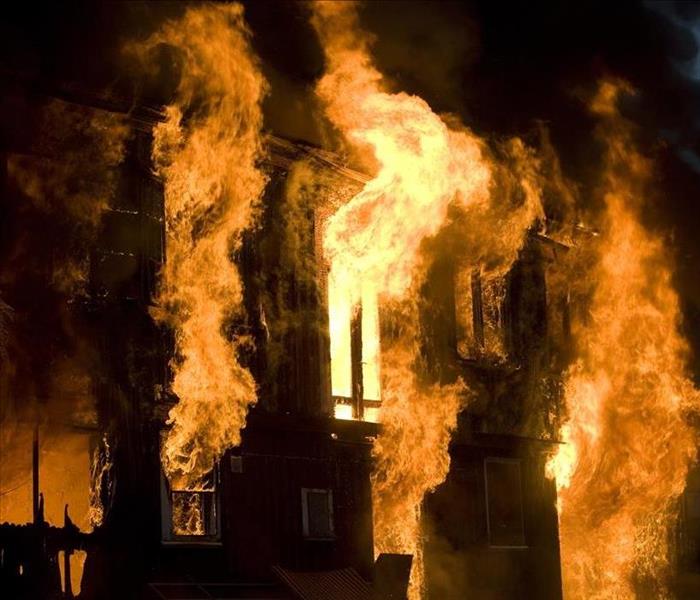 An escape plan can save your family's life and yours from a house fire in Salt Lake City, UT.
An escape plan can save your family's life and yours from a house fire in Salt Lake City, UT.
No one wants to think a house fire can happen to them, but the reality is that over 350,000 house fires occur in the United States every year. Having a fire escape plan in place can help ensure that your family stays safe if this happens to you.
Make Sure Everyone Is Included in Your Plan
Include all members of your household in your emergency escape plan. Pay particular attention to household members who may have special needs:
- Young children
- Elderly family members
- People with disabilities
- Guests
- Pets
Children and family members with a hearing impairment may not wake when a fire alarm goes off. Assign an adult family member to alert them. If you have family members with mobility issues or disabilities that may impair their ability to execute an escape plan, assign someone to assist them. Keep pet essentials, such as leashes or cat carriers, stored along your escape route. Assign a family member to look for your pet and attempt to evacuate it. If you can not get your pet out, leave the door open and call for it. Make sure your guests are familiar with your escape plan.
Plan Two Escape Routes
Smoke or flames may make your primary escape route impassable, so your fire escape plan should include two ways out of every room. The primary exit from most rooms is the door. The most common secondary exit is a window. Make sure both exits open easily and that any security devices have an emergency release.
Pick a Meeting Spot
Decide on a location outside your home where your family members will gather so that you can make sure everyone made it out. The location should be in front of the house so that emergency responders can see you. Common choices include a neighbor's house, mailbox, or street sign. Instruct your family members that no one is to go back into the house once they have escaped.
Make Sure Your Smoke Alarms Work
Periodically test your smoke alarms to make sure they work. You should install a smoke alarm in every sleeping room, outside each sleeping room, and on every level of your home.
Stress Quick Response Times
Make sure your family knows that if the fire alarm goes off they must immediately exit the house. Practice your plan at least once every year to make sure everyone can execute it quickly and correctly.
Create a Backup Plan
If one or more family members can not exit through either of the planned escape routes, instruct them to close all doors between themselves and the fire. They should also put a towel under the door and then go to an exterior facing window and call the fire department to report their location.
Plan for After the Fire
Once everyone is safe, have a plan for beginning the restoration process. Call your insurance company to file a claim. You may need a fire restoration company in Salt Lake City, UT, to assist with cleanup.
The most important thing to do if a fire happens is make sure everyone gets out safely. Having a fire escape plan in place will increase your chances of avoiding injury or loss of life.
Reasons To Steer Clear of Flooded Roads
8/19/2021 (Permalink)
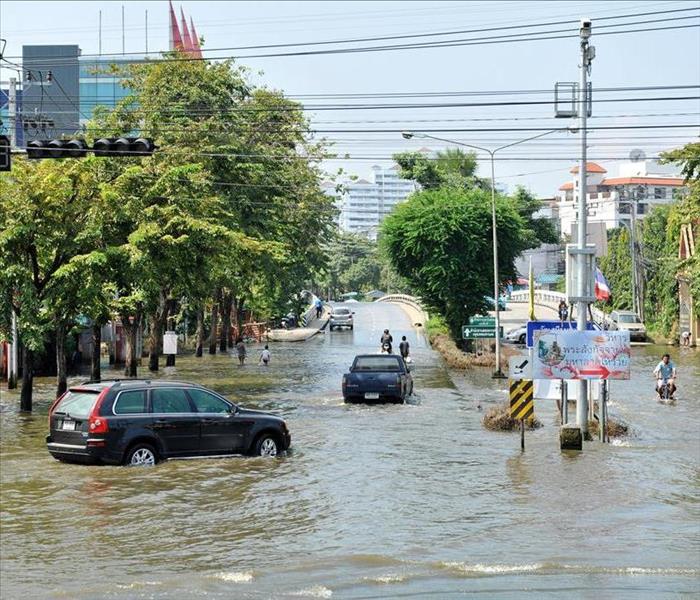 Flood roads in Park City, UT, are dangerous for your vehicle.
Flood roads in Park City, UT, are dangerous for your vehicle.
Storm season in Park City, UT, often results in flooded roadways. While these conditions are inconvenient and can delay your schedule, that's no excuse to try to drive through a flooded street. It's better to stay at home and miss a meeting than to experience some of the consequences of choosing to leave before the storm has passed.
Extensive Vehicle Damage
Your vehicle was not made to drive through deep water. If you drive on flooded roads, your car may never be the same afterward. There are several common problems that occur when a vehicle is flooded:
- Hydro-locked engine
- Short-circuited electronics
- Contaminated fluids
- Rusted components
Flood damage can cost you a lot in repairs or total your car altogether. While it's possible that a great mechanic can fix what is wrong with the engine and certified water restoration experts can get the funky smell out of your upholstery, it makes more sense to just avoid the problem in the first place by staying off the road or choosing a safer route.
Obscured Vision
When a roadway is blocked by flooding, the water is often murky. This means you can't see what's happening beneath the surface of the puddle. It's difficult to gauge just how deep the standing water on a flooded street is, even if you try to use the curb or other signposts as clues. Floodwater can quickly cause damage to the road, resulting in cracks or sinkholes that make the stream flowing across it deeper than it appears.
Another potential risk hidden from sight is all the debris that washes into the road during a storm. It's unlikely that the only thing blocking your path is water. Tree limbs, rocks, and other obstructions are probably in the flooded road as well, making navigation even more treacherous. Rather than taking a chance on a street with standing water, tune in to travel tips on the radio to find a better path to your destination.
Loss of Control
The biggest hazard of driving on flooded roads is the possibility of losing control of your vehicle. If the engine seizes up and stalls, you may not even be able to steer it to the side of the road before it stops working completely. You then have to wait for someone to tow your vehicle out of harm's way, hoping that no one else loses control and crashes into it in the meantime.
If the floodwater is both deep and fast, it can carry large objects, such as your vehicle, with it. You may not be able to get your door open to escape, which leaves you trapped in a moving car that you can't steer, going whichever direction the flood takes you. No one wants to be in a position with such an uncertain outcome.
There's never a good reason to drive through a flooded street. If you must get on the road, choose a route with adequate drainage or higher elevation so that you can safely get where you need to go. If no such route exists, it's better to wait out the storm than face the peril of the flood.
Confront the Damage From a Flooded Toilet
8/11/2021 (Permalink)
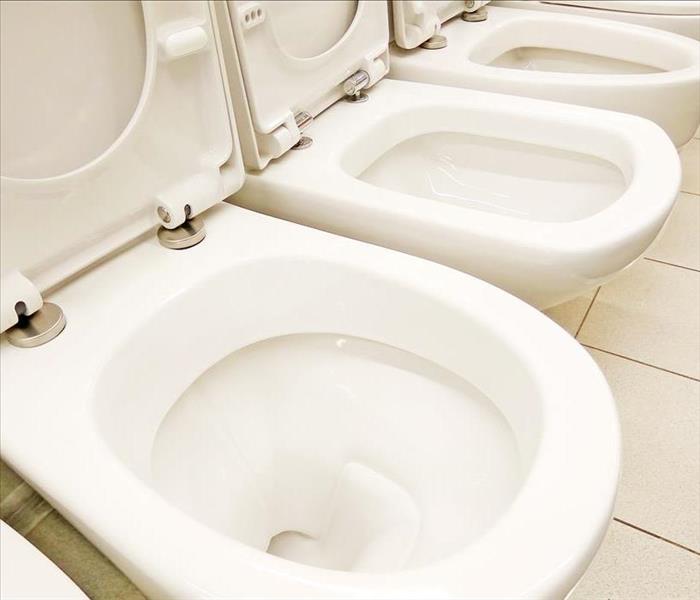 The damage caused for a flooded toilet in your business in Salt Lake City, UT, must require professional help.
The damage caused for a flooded toilet in your business in Salt Lake City, UT, must require professional help.
The sewer damage that results when a flooded toilet overflows throughout your Salt Lake City, UT, a business can quickly add up to a lot of money. The good news is that your commercial property insurance policy probably covers a lot of the damage. With this in mind, it's important that you know which steps you can take yourself and which work should be left to professionals.
Take These Steps Immediately
As soon as you notice the flooded toilet, you need to complete a few vital steps:
Turn off the water. You can do this by lifting the float inside the toilet tank, turn off the valve at the back of the toilet, or shut off the water at the building's water main.
Mop up as much water as possible. It doesn't take long for water to cause expensive damage to your building.
Clean up organic matter. This includes dirt and other substances that may have been in the toilet. You must be aware of the dangers of black water, at this point. The bacteria from waste in the water can have serious side effects, especially during extended contact.
Contact sewer damage cleanup and remediation professionals. In addition to handling any black water and other dangerous contaminants, these experts may point out potential areas of mold growth and help you avoid future water damage.
If the flooding is confined to a small area, you may clear the clog and clean up the mess on your own. However, if there's any possibility that you're dealing with anything other than clean water, you're better off turning the job over to professionals. Depending on how widespread the damage extends, you may need to take additional steps, such as contacting the sewage company.
Respond to Further Damage
If water from the toilet has traveled from one floor of the building to another, it may be necessary for cleanup crews to tackle some demolition and reconstruction. For example, flooring and ceiling materials may need to be removed, disposed of appropriately, and then replaced. Wet materials, including drywall and insulation, may need to be thoroughly dried out, disinfected, or replaced. Your insurance company may require you to work with damage cleanup and remediation professionals.
Prevent Mold Growth and Damage
Mold is a common concern after any type of water damage. High levels of moisture can cause unseen pockets of humidity that provide an ideal breeding ground for mold spores. Unfortunately, within just a couple of days, there may be enough mold growth to encourage the spread of multiple colonies. If you don't know what to look for, this trouble could continue unseen until serious damage has been done. Cleanup technicians may test for mold and take steps to clean up and prevent spread.
Avoid More Unpleasantness
Cleaning up after an overflowing toilet isn't one of the things that most business professionals are excited about. However, when sewer damage happens, these simple steps can help keep further damage under control. Your quick response and the work of professionals is the best way to limit further harm and get your business back underway.
How to Make a Home Fire Escape Plan
8/4/2021 (Permalink)
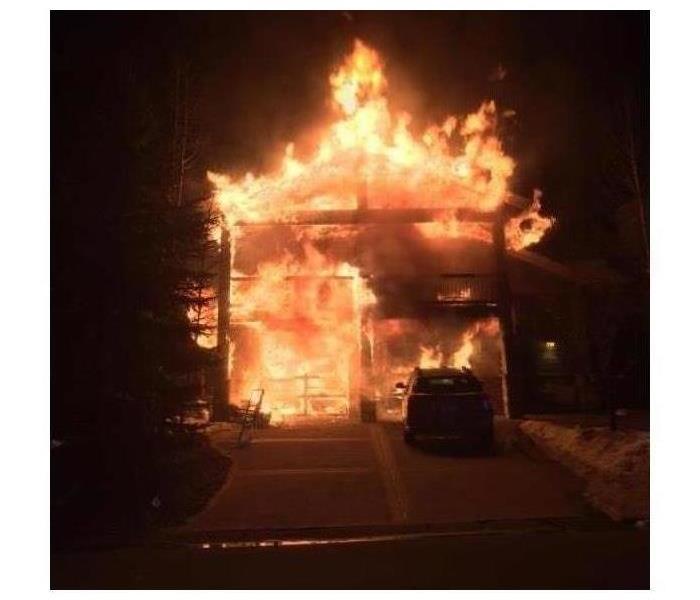 A house on fire is dangerous and a traumatic experience.
A house on fire is dangerous and a traumatic experience.
No one in Salt Lake City, UT, wants to experience the devastation of a house fire, but in order to keep your family safe, you need to put a plan in place should once occur. Experts recommend working with your family to create a fire escape plan and practicing it at least twice a year so that everyone knows what to do.
Here are some ideas for what your plan should include.
1. How to Get of the Rooms.
Every household member should know at least two ways to escape each room in the home. If the fire prevents someone from leaving through the door, is there a window to crawl out of? Teach children how to open windows.
2. How and Where to Find Fire Escape Ladders.
If you have a two-story home, ladders can help people escape through top-floor windows. These are best used by adults and older children. Make sure everyone knows how to use them.
3. Where to Meet.
As part of your emergency escape plan, pick a meeting spot a safe distance away from the home. Everyone should know where it is. It is very important that children understand that everyone will meet at this safe meeting place and that they don’t need to try to rescue anyone on their way out of the home.
After your fire escape plan is established, your family should practice putting it into place. Practice until it can be completed in less than two minutes. In addition, your household can practice low crawling and waking up to a smoke alarm. Teach everyone how to dial 9-1-1 and stop, drop and roll.
The thought of experiencing a house fire is a scary one, but it’s better to come up with a fire escape plan in case of an emergency than it is to ignore the issue. Having a plan in place will help keep you and your loved ones safe.
For more information, please visit us at http://www.SERVPROnesaltlakecityparkcity.com.
Out with the Old: Changing your Pipes
8/4/2021 (Permalink)
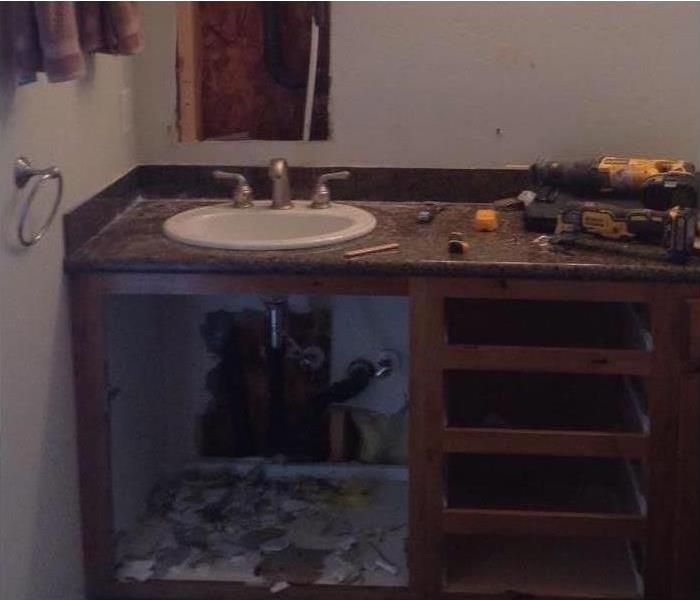 Broken pipe causing water loss in a Park City, UT home
Broken pipe causing water loss in a Park City, UT home
From the 1970s to the 1990s, a specific sort of pipe was used in a lot of commercial plumbing. Polybutylene was thought to be the pipe of the future because it was inexpensive to make and easy to install. After a few years, however, those buildings started having plumbing problems. These pipes are not used in Park City, UT, today because they inevitably wear out, and they cause significant water damage when they do.
Here are some reasons these pipes must be replaced if they are part of your building's plumbing.
1. Exposure to treated water makes it brittle. One of the reasons this particular piping does not work for plumbing is that the water itself destroys the pipe. The chlorine and antibacterial chemicals used to make drinking water safe make the polybutylene pipes brittle and prone to breakage. Over time, they cannot be fixed. They must be replaced.
2. Disintegrating parts get stuck in the water. Another startling effect of this type of piping is that as it disintegrates, it flakes off and leaches chemicals into the water supply. New plumbing made from safer materials is a necessary upgrade.
3. It costs more to maintain than to replace. Replacing these pipes has a comparable cost to replace the carpet in your house. The piping change isn't inexpensive, but neither are all the costs from having to hire water remediation experts to clean up every time you have water damage.
4. It drives down the resale value of your building. Because this piping causes so many problems, it needs to be fixed before you put your property on the market. Most realtors won't even show a commercial property that still has old pipes in it. The pipes must be replaced before the building is likely to sell.
If your commercial building seems to have more water damage problems than it usually does, polybutylene pipes may be the culprit. Have the pipes replaced to avoid additional repair expenses.
3 Steps To Take After Water Damage
7/27/2021 (Permalink)
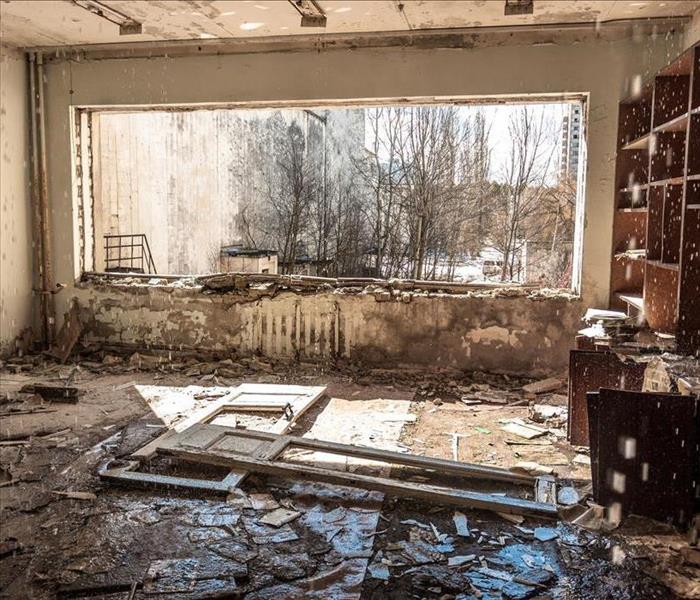 A flood in your Salt Lake City, UT, home it's a severe problem. It must be treated as soon as possible.
A flood in your Salt Lake City, UT, home it's a severe problem. It must be treated as soon as possible.
If you have water damage in your home from an overflowing toilet, leaking pipe, or a flood, you may be wondering what steps you should take. These three tips will get you started.
1. Contact Your Insurance Company
Most homeowners' policies cover damage for sudden and accidental discharge of water, such as damage caused by broken pipes. However, flood damage is often excluded, unless covered by a separate flood policy. Contact your insurance company as soon as possible to get the claims process started. Take photographs of the damage. Keep any receipts for temporary repairs made before the claim settlement.
2. Dry Out Your Home
If it is safe to enter your home, begin water damage restoration within 24 to 48 hours. Waiting longer than this can lead to future problems, such as mold growth. Wear protective gear and have the electricity and gas shut off to your home. Open windows and doors to increase air circulation. Remove wet items, such as carpet and upholstered furniture. Other materials, such as drywall, insulation, and flooring may also need to be removed. If you have extensive damage, consider contacting a restoration service in Salt Lake City, UT, for assistance.
3. Check for Mold
The faster you can perform water cleanup and dry out your property, the less chance there is of mold, but it can be difficult to completely avoid the problem. If you notice musty odors, brown, green, or black stains, or other signs of mold, you may need to have mold remediation done to remove the problem before it gets worse. Mold tends to grow in places with high humidity. Keep humidity levels down by using fans, air conditioners, and dehumidifiers.
A small area of water damage may be cleaned up with a mop and bucket. However, more extensive damage may require days or weeks to fully restore. The faster you begin the process, the better your chance of avoiding additional damage will be.
Individual Assistance Grants From FEMA
7/15/2021 (Permalink)
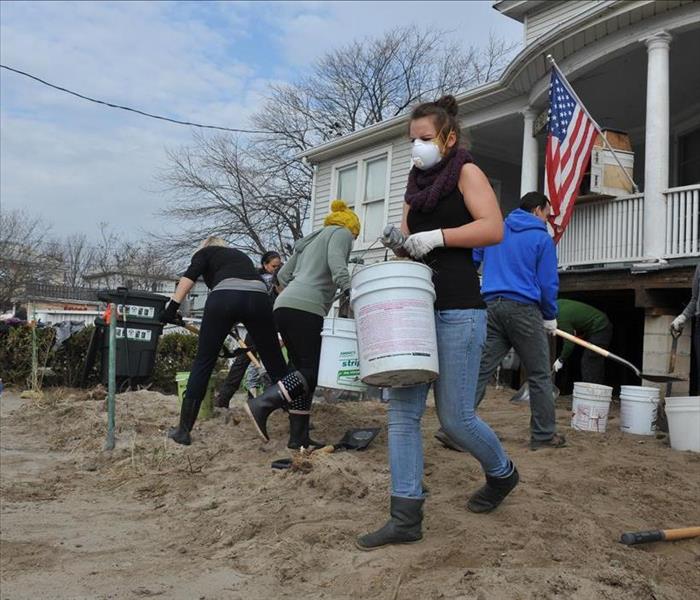 Protecting your home in advance will prevent serious and expensive storm damage in the future.
Protecting your home in advance will prevent serious and expensive storm damage in the future.
After a major natural disaster affects your Salt Lake City, Utah, home, FEMA, or the Federal Emergency Management Agency, may be one of the first sources of help. You can seek this assistance as an individual, and one of your first steps should be registering with the agency as soon as possible after damage to your home. You'll need to have specific information and paperwork available:
- Address of your damaged property
- Current contact information
- Insurance information
- Social security number
- Banking information
- Annual household income
What To Expect From Grants
Whether your property has been affected by wildfires or flooding, the costs of recovery, including the work completed by property repair and reconstruction professionals, can be overwhelming. This assistance is particularly helpful for people without insurance or with gaps in their insurance. The grants may cover:
- Home repairs
- Temporary shelter
- Medical and dental expenses
- Childcare costs
- Funeral expenses
- Replacement of personal property
After registering, a FEMA representative will call to schedule an inspection before approving the assistance. It's important to note that scam artists may show up claiming to be official inspectors, so ask for an identification card. Do not provide your credit card or any bank account information because there isn't a charge for these inspections.
Information From Insurance Providers
If you haven't yet experienced a major disaster, it isn't too soon to learn as much as possible about surviving and recovering. Ask your insurance provider about the steps you can take to protect your home against damage from an earthquake, flood, wildfire, or landslide. The more you do beforehand to prevent damage, the better off you'll be.
An Offer of Help
It isn't always possible to emerge unscathed, however, so research the ways that the FEMA Individual Assistance Program could help you. After all, the experience of a natural disaster is scary enough without knowing where you'll be sleeping at night; it's comforting to have many sources of assistance available.
4 Advantages of an Electronic Claims Service
6/28/2021 (Permalink)
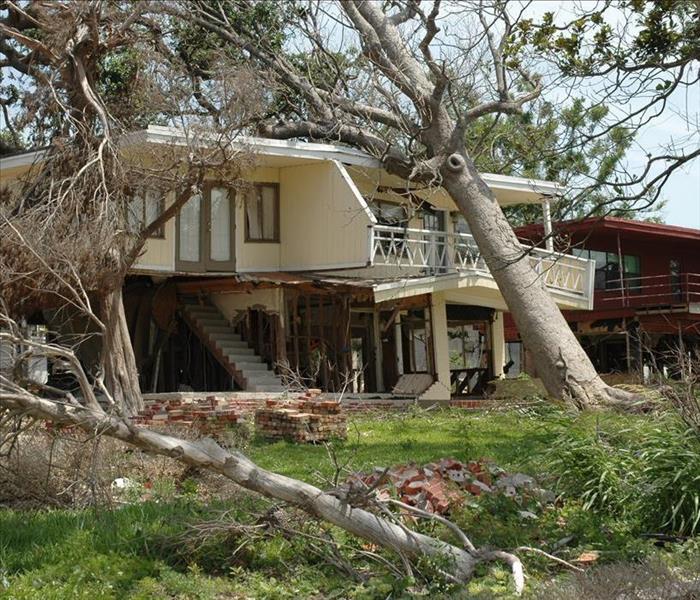 Utilizing an Electronic Claims Service has its benefits.
Utilizing an Electronic Claims Service has its benefits.
When your home is hit by a disaster in Salt Lake City, UT, immediate action is necessary to minimize loss. First, you must call to get your insurance agent to inspect the damage so that you can file an insurance claim. Then, restoration can finally get underway to minimize loss. These days, with the help of SERVPRO electronic claims service, the process is becoming increasingly faster and more efficient, allowing for numerous benefits.
Benefits of an Electronic Claims Service
1. All the Data Is Saved in One Secure Location
Every stage of the claims process is documented and placed on the electronic claims service site. These days, there's very minimal, if any, sorting through piles of paperwork and looking on multiple company sites. Electronic claims services enable professionals to obtain all your damage information from one website. They can also access it from any computer or mobile device, whether in the office or the field.
2. The Information Is Updated and Accessed in Real-Time
As soon as a professional uploads information to the database, it's available for others to access. This enables a smoother insurance claim and restoration process with less downtime.
3. The Agents, Adjusters and Service Providers Have Access
From insurance agents and adjusters to damage restoration specialists, everyone can access your information about the entire ongoing process at all times. The service also provides professionals access to nationwide collected data from various types of claims to make sure you receive fair costs and compensation.
4. Communication Is Made Easier for Everyone
Property owners, insurance agents, adjusters and service providers have an easy line of communication throughout the entire process. Everyone involved can simply go to the account and interact with one another.
An electronic claims service makes filing an insurance claim a simple, efficient procedure from start to finish. Whatever type of disaster your home endures, this technology is invaluable. The damage to homes is mitigated and restored faster than ever.
Mold and Mildew: Do the Differences Matter?
6/28/2021 (Permalink)
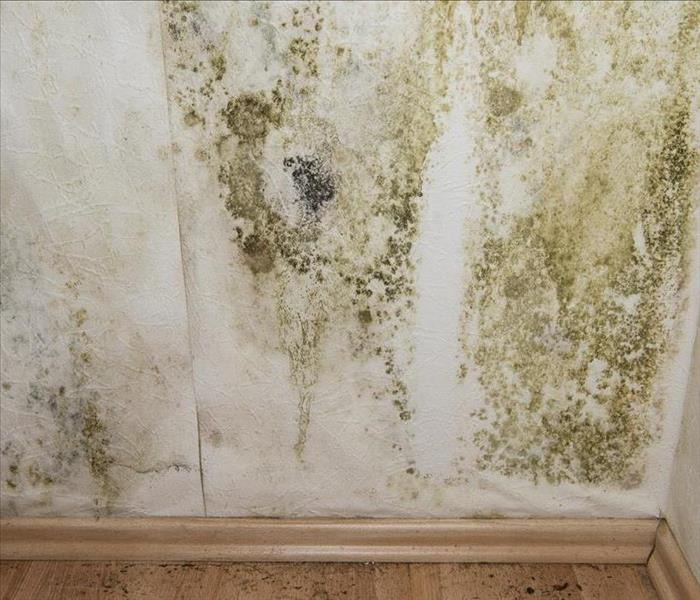 Mold damage in Salt Lake City, UT.
Mold damage in Salt Lake City, UT.
It is important to understand the difference between mold and mildew before addressing a mold damage problem in your Salt Lake City, UT, home:
- Mildew is often used as a generic term that refers to a variety of molds and fungi, but mildew has distinct characteristics of its own.
- Mold refers to all microscopic fungi with a multicellular filament form.
- Mold is one type of fungus. Other forms of fungi include yeasts and mushrooms.
While there are beneficial applications of mold, you certainly don't want to find any growing in your shower, on your walls, or anywhere else in your home.
Mold and Mildew
Similar Beginnings, Different Problems
Mold and mildew growth is encouraged by the presence of moisture, oxygen, and a food source. The two problems have distinct and visible differences. Mold may originally look like dirt. It comes in a variety of dark shades, including green, red, and black. Mold damage often has a fuzzy appearance. Mildew, however, has a light white or gray appearance initially, turning brown as it grows. It has a flat profile, appears powdery, and shows up shaped like small dots. Mold growth tends to be more problematic than mildew because mildew causes surface damage, but mold eats into wood, paper, carpeting, and other surfaces.
Prevention Techniques
Fortunately, it is pretty easy to prevent the growth of mold or mildew. Look for problem areas in your home. If you have rooms or corners that don't get a lot of sunlight, that retain moisture, and that have limited ventilation, there's a potential for damage. The presence of dirt and other debris can increase the risk of mold or mildew, so address this issue as well.
Effective Solutions
It's easy to confuse mold and mildew, but when you have a mold damage problem, it's important to know what you're dealing with to provide an appropriate solution. The best option is to contact mold and mildew cleanup and remediation professionals. These experts have the training, tools, and experience to handle the problem effectively.
How Electronic Records Can Help Insurance Companies
6/28/2021 (Permalink)
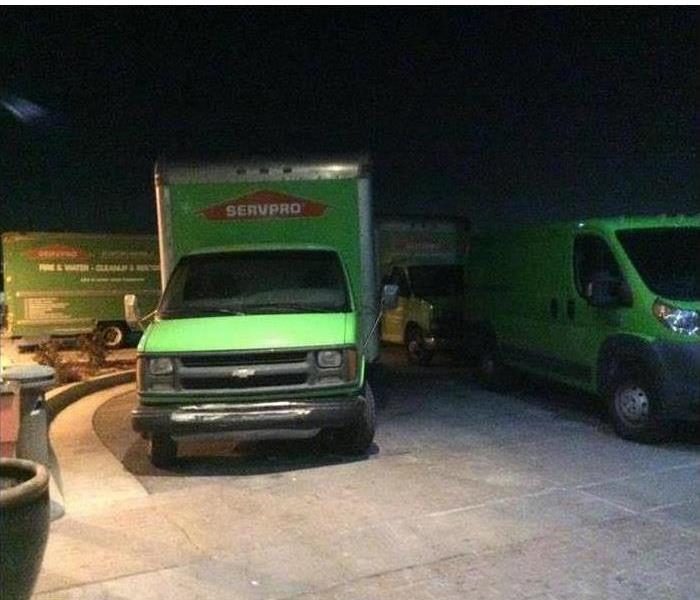 Electronic records can help insurance companies.
Electronic records can help insurance companies.
Processing an insurance claim may have many steps, but it doesn't have to be a hassle. When you choose certified remediation specialists who use electronic records to store information about your cases as your preferred vendors, processing a claim can become quite simple. Everything you need to know for your claims is right there. Electronic records make it easier to find the information you need and access them efficiently.
Electronic Records Can Help Insurance Companies
Easy To Search
When you work with a company such as SERVPRO, you have access to all the information you need at any time of the day. The Claims Information Center makes it easy to search locally, regionally or nationwide for:
- Type of claim
- Job cost
- Cause of loss
- Response times
You can also find the information you need for your client's insurance claim, including an itemized list of losses and a detailed account of the entire remediation process from assessment to restoration. You can log on at any time to see exactly what the process looks like for your client's home.
Easy To Share
Another benefit of electronic records is that they are easy to share. Gone are the days when clients must wait for paper documents to be filed and mailed to the insurance agent. The report can just be sent via email. This is especially helpful if more information is needed. Rather than putting the payment on hold until all the necessary documents make it through the mail, you can retrieve information instantly. It cuts down on the time it takes to process claims, which in turn helps everyone get paid more quickly.
Processing an insurance claim is much easier with SERVPRO's CIC. You get all the information about the repairs that your clients in Park City, UT, need just by logging in and finding the files. Electronic records help agents and insurance companies by making the claims process more manageable.
Important Smoke Alarm Replacement Tips
6/24/2021 (Permalink)
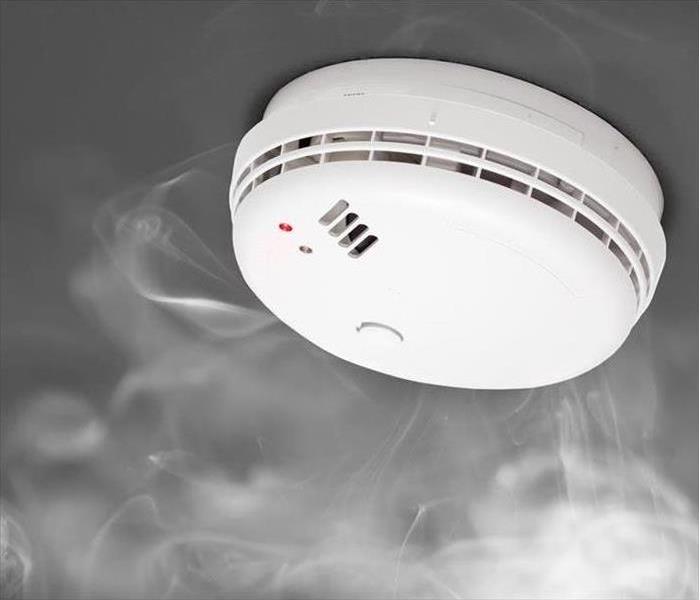 Keep your smoke alarm up to date in your Junction, UT home.
Keep your smoke alarm up to date in your Junction, UT home.
With all the time you spend in your home in Junction, UT, you want to know that you will be prepared and promptly alerted if a fire occurs. With each smoke alarm in your home replaced as necessary, you can feel confident that they will alert you in case of a fire.
1. Frequently Replace Batteries
Thanks to technological advances, alarms do not need to be replaced as frequently as they did in the past. However, just because the alarms themselves need to be replaced only every 10 years or so, this does not mean you can go years without replacing their batteries. A smoke detector should have its batteries replaced once a year.
2. Test Your Alarm
Even when you replace the batteries of your smoke alarm as needed, dysfunctions can still occur. Checking every alarm in your home once a month can help ensure that each alarm is functioning as it should. With most alarms, you can do this by pressing a button labeled ‘test.’ When testing your alarm, be prepared for the loud, consistent noise it will emit. If you don’t hear this response, it may be an indicator that your batteries need to be replaced.
3. Listen for Beeping
A smoke detector or alarm that needs new batteries will often spontaneously make a short beeping or chirping noise. Even if you have replaced your batteries within the year, the series of chirps may indicate that another change is required. If the alarm continues beeping after the batteries have been replaced, it might be time for a new alarm.
Keeping every smoke alarm in your home up-to-date is an important way to protect your home, yourself, and your loved ones. Although these measurements can alert you of a fire, destruction is not always preventable. If your home suffers from a fire, you may want to contact experts in fire damage restoration.
Common Causes and Remedies for Sewer Odor
6/24/2021 (Permalink)
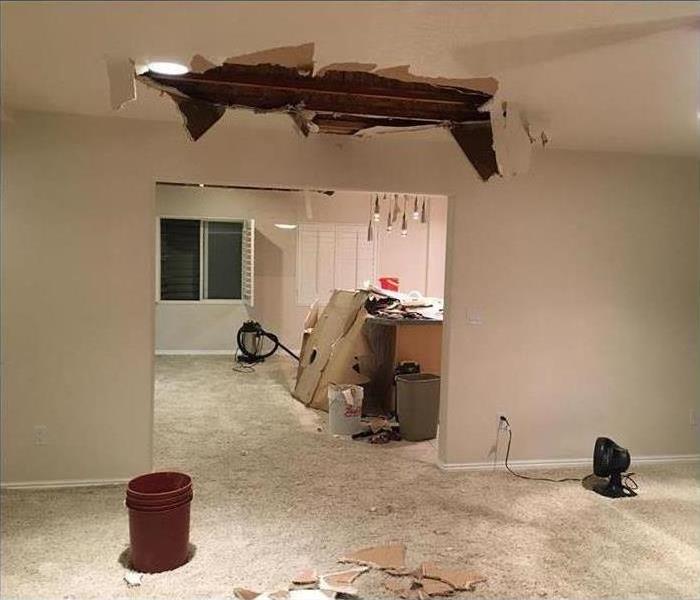 Roof damage from storm in Sugar House, UT home.
Roof damage from storm in Sugar House, UT home.
Having a sewer smell in your commercial building is unpleasant. While the fumes may not be harmful, they can certainly be an unwelcome distraction. There are several reasons you may be smelling sewer gas in your building in Sugar House, UT, and most of them have pretty simple remedies.
Causes of the Odor.
Smelling sewer odor does not usually mean that you have raw sewage wreaking havoc somewhere in your building. The more likely cause is the failure of one of several apparatuses that function to direct the gas outside. There are three main causes of indoor sewer smell:
- Dry traps with no wastewater to prevent gases from coming back through the plumbing.
- Blocked vents with a clog or backup that is preventing the gas from escaping through the normal channels.
- Damaged drain lines that release sewage under the property instead of carrying it away.
To get rid of the smell, you must first locate the problem. It may have an easy fix that you can do yourself, but it's important to call a plumber or sewer remediation services if you need to do so.
Solutions for the Odor
The first thing you should try to do is pour clean water down the drain from whence the smell comes. Dry traps from underutilized drains are the most common cause of sewer odors in buildings and making sure that you use the drain frequently can help prevent the problem or help resolve it once it occurs. If that doesn't work, your drain may need to be cleaned. Disinfecting the drain takes care of any bacteria that may be causing the smell. If none of your efforts get rid of the smell, however, it is time to call in the professionals to assess a potentially larger problem.
Sewer smell can happen any time there is a backup or some other type of plumbing problem. If you can't get rid of the problem on your own, calling a plumber can help you get your building smelling fresh and clean again.
Rain Isn’t the Only Thing To Worry About During a Storm
6/22/2021 (Permalink)
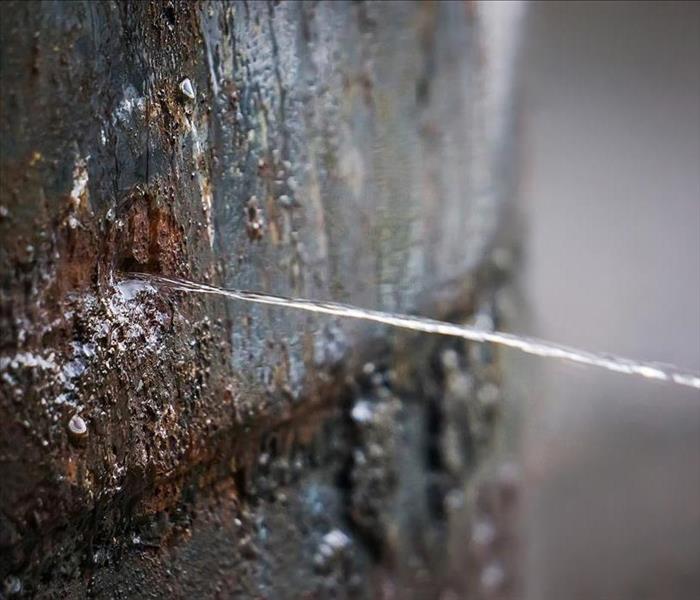 A winter storm can cause bursting pipes.
A winter storm can cause bursting pipes.
When you think about your business flooding, your mind might automatically go to rain and storm surge. This is not always the case. During winter storms, you have to worry about things like a burst pipe due to freezing conditions. Fortunately, there are a few things that you can do to prevent this type of flooding from happening.
4 Things To Do To Prevent Flooding
Drain What You Can
Drain water from where it builds up.
- Pools
- Pipes
- Sprinkler supply lines
- Toilet tanks
No matter where your business is, these things should be drained before a bad storm, if only to prevent standing water from becoming a problem.
Close Valves
Depending on the type of pipe, you may want to close off any valves before you drain them. A burst pipe is easily prevented by making sure that it doesn't have water in it. No water usually equals no freezing or bursting during a storm.
Prevent Freezing
Aside from insulation, there are a few ways you can prevent a frozen pipe. One way is to make sure warm air is circulating around your plumbing. You can leave sink cabinets open or prop your office bathroom door open if your heat is on in the building.
You can also leave your faucets dripping. Moving water is less likely to freeze. You can also keep your climate control system set higher than you normally would at night. Although this might increase your heating bill, it is a lot less expensive than having to replace pipes and utilize a flood remediation company in Salt Lake City, UT.
Insulate Pipes
If you cannot completely drain pipes or as an added measure of protection, make sure your pipes are insulated. You can purchase sleeves and other forms of insulation to make sure that your pipes are protected. In the case of pipes that you cannot insulate, you can wrap them when winter storms are imminent.
No matter what type of storm it is, a burst pipe can lead to big problems for your business. You can prevent this from happening.
Prevent Mold and Other Secondary Damage
6/3/2021 (Permalink)
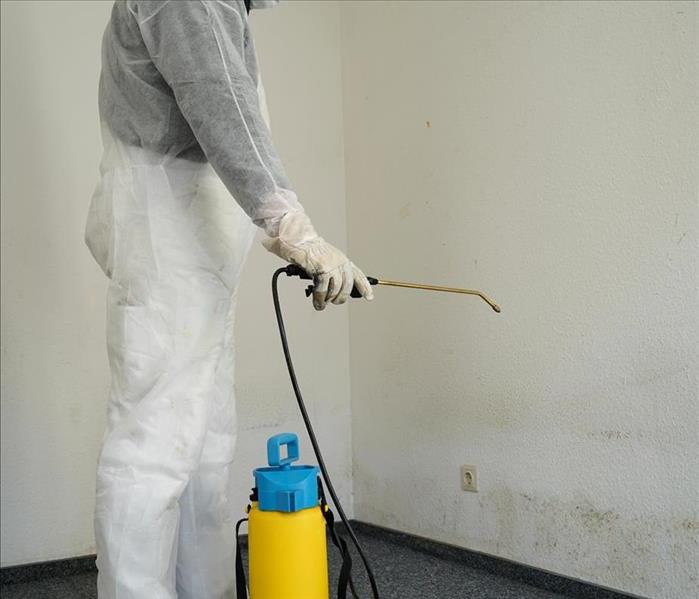 Untreatted water damage can lead to black mold.
Untreatted water damage can lead to black mold.
Molds exist naturally and over thousands of years have developed the ability to survive in harsh conditions. However, some circumstances provide an open invitation for black mold and other varieties to move in:
- High humidity levels
- Organic materials
- A day or two
When flooding, pipe leaks, or other water damage has affected your Salt Lake City, UT, commercial property mold growth is a concern as part of the possible secondary damage.
A Second Wave of Trouble
It's not surprising that water causes a significant amount of property damage, and property owners generally move quickly to prevent lasting destruction. Secondary damage, on the other hand, sometimes goes unnoticed until the problem has grown to expensive proportions. When water is allowed to sit for days or even hours, new damage occurs:
- Black mold growth
- Corrosion
- Electrical damage
- Wood rot
The damage caused directly by flooding or a burst pipe is primary damage, and the damage that develops as the water sits is secondary.
Your Best Course of Preventative Action
It is possible to prevent or at least limit secondary water damage. After addressing the initial event, it's time to take preventative steps:
- Work quickly to combat high humidity caused by evaporating water. The added moisture in the air warps and weakens building materials, such as wood and drywall. Remove water, plug in fans, and increase ventilation as much as possible.
- Make sure that all surfaces are completely dry. Mold often lurks behind the walls, in the vents, and under the carpets. Ensure the safety of your commercial property by hiring cleanup and restoration professionals with the experience and resources to locate and address problem areas.
- Chemical biocides are usually required to ensure that existing mold is treated successfully. It is also necessary to prevent future colony growth. Some filtration devices and sanitization techniques remove spores before they settle on vulnerable surfaces.
Don't give black mold time to cause secondary damage. Act quickly when water affects your property to completely dry and clean all surfaces to protect your property's long-term survival.
4 Tips About Smoke Detectors
6/3/2021 (Permalink)
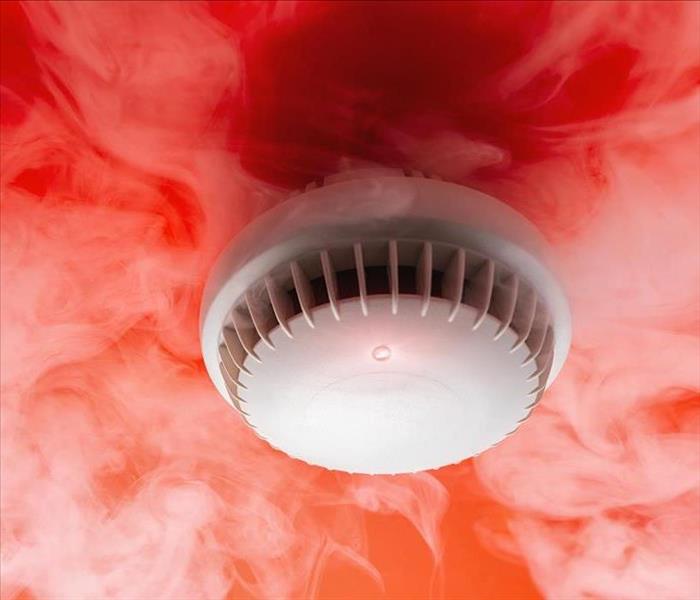 Smoke detectors are very important to keep you and your family safe.
Smoke detectors are very important to keep you and your family safe.
How often do you think about your smoke alarms, and do you have multiple alarms? A fire alarm is an essential piece of safety equipment, but many American households do not have an adequate number of devices in working order. If you are not aware of the current state of your alarms or are unsure of the number you should have for your home, contact the fire department or a fire restoration service in Salt Lake City, UT. However, to make the process easier, you can follow the four tips below.
4 Things to Know About Smoke Detectors
1. Number of Smoke Detectors Needed
Preventing extensive smoke damage is about early disaster intervention, meaning immediate response to a house fire. The best way to ensure the fastest response time is to have the appropriate number of smoke alarms for your home. The basic rule is to have at least one smoke alarm in every bedroom, outside sleeping areas, and on every floor of the home. For a two-story, three-bedroom home, that would mean a minimum of three alarms.
2. Average Lifespan of Detectors
A fire alarm does not have the same lifespan as your roof or some appliances. Most alarms have a maximum usable lifespan of between eight and 10 years. It is a good idea to put a date on detectors or set notifications on your phone or calendars as reminders.
3. Types of Detectors
Fire damage can occur during fast-moving fires or slow, smoldering fires. There are different devices to alert you to which type of fire you are dealing with. An ionization alarm reacts quickly to flaming or fast-moving blazes. A photoelectric alarm is quicker to sense smoldering or smoky fires. You should have each type in your home or look for combination detectors.
4. Emergency Escape Plan
Did you know you likely only have about three to four minutes to escape a house fire? Because of changes in furniture and construction, house fires can spread more quickly than ever before. Make sure you have a practiced fire escape plan.
A fire alarm can save your life. Make sure you have enough for your home to protect your family.
Tips for Cleaning Up After a Sewage Flood
5/6/2021 (Permalink)
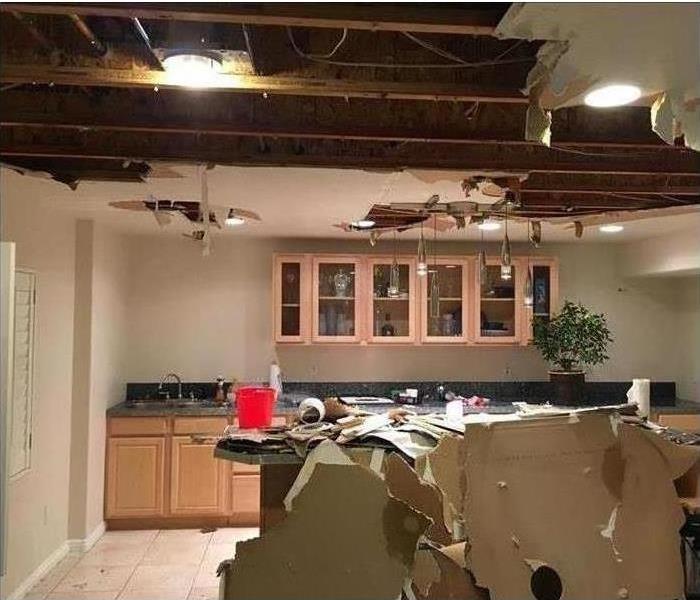 Ceiling damage from water loss in Salt Lake City, UT home.
Ceiling damage from water loss in Salt Lake City, UT home.
There are some possible disasters you can prepare your Salt Lake City, UT, home for, but one that might catch you completely unprepared is a sewer flood. These floods can happen when weather conditions back up your neighborhood’s sewer line and then back up out of your toilet. You will likely need the assistance of a professional sewer cleanup crew to rectify this issue, but there are a few actions you can take to ensure your family and the remainder of your home stays safe.
3 Tips to Clean Up After a Sewage Flood.
1. Do Not Touch the Flood Water
After a sewer backup, the water that flows from your toilet is likely contaminated and is what professionals call “black water.” It may contain human and animal feces, sewer chemicals and other biohazards. Seal off the nearest door and avoid touching any of the water with your bare hands. If you must block water with towels or other absorbent material, wear thick rubber gloves and a breathing mask to protect yourself.
2. Clear the Outdoor Area
Once the sewer cleanup crew arrives, they may bring one or more large tanker trucks and other vehicles that transport sump and trash pumps that will help them drain away the contaminated water. Try to give them plenty of room by moving your cars and other objects that might block their way. Prevent children and pets from roaming too close to the vehicles once they arrive.
3. Ask About Deodorizing Services
A flooded toilet can cause unpleasant sewer smells to linger, even after the water is gone. However, a professional cleanup crew might have several options for deodorizing your home. This service goes a step beyond cleaning, as the processes these professionals use are unique and clean the air as well as your home’s floor and walls to ensure unwanted odors do not return later.
When sewers malfunction and cause a flood in your Salt Lake City, UT, home, it can be distressing. However, a professional sewer cleanup crew can give you peace of mind when it comes to draining away the water and leaving your home smelling clean and fresh once more.
Dealing With the Aftermath of Water Damage
4/30/2021 (Permalink)
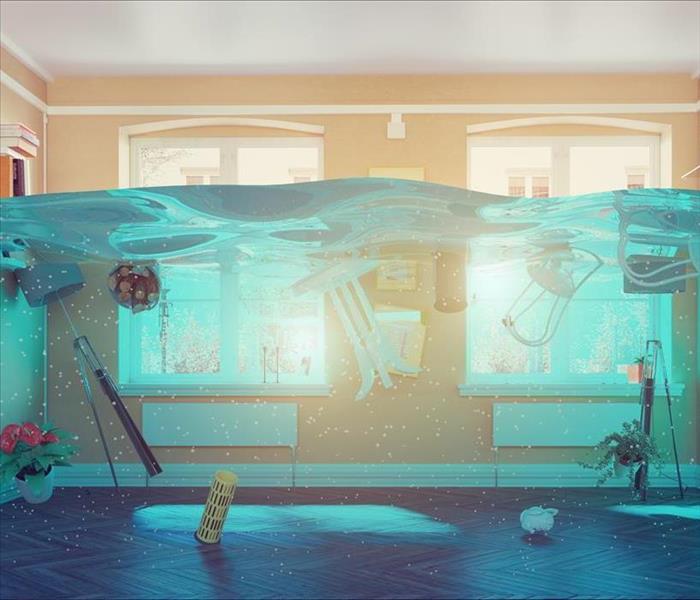 Water damage can lead to severe damage if not treated right away.
Water damage can lead to severe damage if not treated right away.
The aftermath of water damage on a residential property can be devastating for unsuspecting homeowners. It is easy to look at a flooded living area and feel like all is lost, but fear not, the damage is not typically as bad as it seems. However, as with any natural or manmade disaster, you need to take action to limit the loss. Every homeowner should take three steps to protect their property after a water problem.
3 Steps To Deal With The Aftermath Of Water Damage
1. Mitigate Further Damage
Whether the damage is the result of an exterior flood or broken pipes, you should try to limit as much damage as possible. In fact, many insurers require homeowners to take mitigative action to prevent further loss. You can turn off the water supply to your home or the affected area, put out buckets for a leaky roof, or call for assistance.
2. Contact Your Insurer and a Mitigation Specialist
When water damage occurs, your first phone call should be to your insurance company, notifying them of the problem. The insurer will typically schedule a time for an insurance adjuster to come out and assess the property.
Beyond the insurance company, contact a water restoration service in Salt Lake City, UT, for an emergency assessment. The company will send out a crew to inspect the property and offer any mitigation services to limit damage to your house.
3. Document the Loss
Before the restoration service gets too far along in the water cleanup process, you should take pictures of the damage. Most insurance companies will want homeowners to create a statement of loss and having photographs to prove damage help speed up the claims process.
No homeowner wants to deal with water damage, but if you have to, it pays to know how. The three steps above are not exhaustive. For more extensive information, you might consider contacting your insurance representative or a water restoration specialist.
Alternatives to Using Chemical Drain Cleaners
4/16/2021 (Permalink)
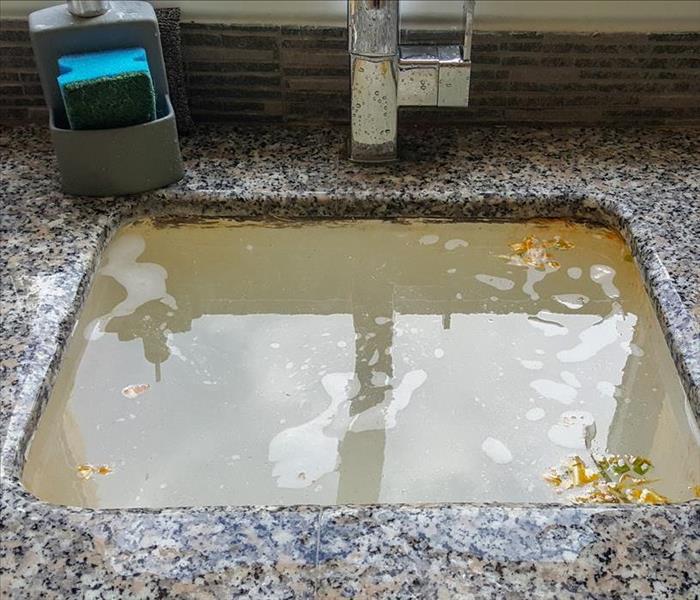 Clogged drains can cause damage to your home.
Clogged drains can cause damage to your home.
A chemical drain cleaner is a powerful tool when it is used correctly in a clogged drain. However, they can cause damage in the wrong situation.
The chemical cleaners produce heat, and this can lead to damage:
- Weakened older pipes may develop cracks and leaks.
- Plastic pipes may become warped and misshapen.
- If the drain is completely blocked, the chemicals will sit in one place and eat through the pipes even if they are relatively new.
In addition to these risks, the chemicals could harm you and your environment:
The chemicals in drain and sewage cleaning products are toxic and are generally more damaging to skin than to plastic and metal pipes.
Even breathing the fumes could lead to irritation.
Before you treat your drain with chemicals, consider the risk of damage to the piping system. It may be worth your time to reach out to water damage cleanup and repair professionals.
How Chemical Cleaners Work
If you understand how drain cleaners work, you'll be better prepared to make the right decision about whether to use them in a clogged drain. There are three types of chemical cleaners:
Although the makeup of these products are different, they all cause a chemical reaction, either adding electrons or removing them from the gunk in your pipes. However, as the fats, oils, and grease break away from the clog, they simply move further down the drain and end up forming a new clog deeper in your pipes.
Alternatives to Drain Chemicals
There are two methods you could try before pouring chemicals down your drain. First, you can try manually clearing the clog. Secondly, you could try a non-toxic enzyme cleaner that introduces living bacteria or enzymes into the pipes. This option may take 24 hours or so before you see results.
For the Best Results
Professional cleaners are some of the best Salt Lake City, UT, professionals to address your clogged drain issue. If you have already put a chemical in the drain, be sure to alert the technicians before they start working.
What To Do When You Have Black Water From Flooding
4/12/2021 (Permalink)
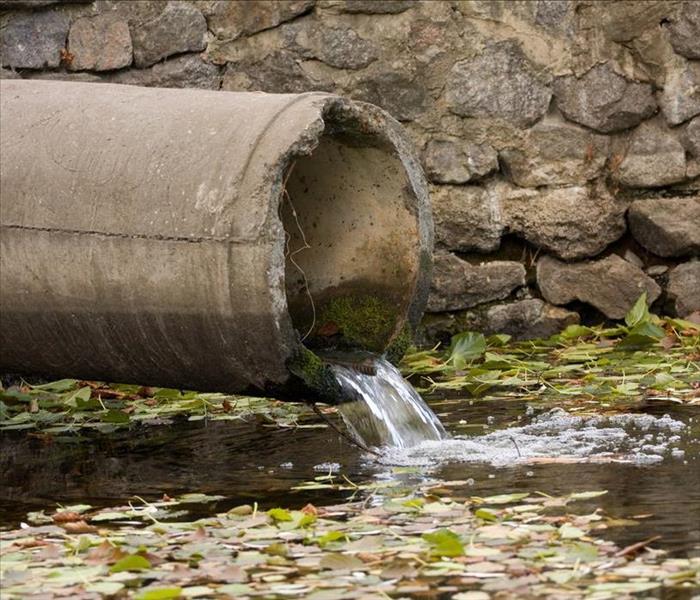 Sewage water is called black water.
Sewage water is called black water.
When you have flood water in your building it is important to remove it as quickly as possible to mitigate the amount of water damage to your property and reduce the chance of future problems, such as mold growth. Before you can begin removing the water, you must first determine what type of water is present in the structure.
Categories of Water
The type of remediation you need depends on how the water in your structure is classified. Water from flooding is categorized in three ways:
- Water from a source that does not contain excessive microbial content is called clean water. Water from a broken supply line is an example of clean water.
- Water that contains a large number of microorganisms and their nutrients is considered gray water. Water from a sump pump failure is an example of gray water.
- Water that is grossly unsanitary because it contains pathogens such as sewage is called black water. Contaminated flood water is one such example.
Remediating Black Water
This type of water may contain hazardous substances such as human or animal waste, pesticides, gasoline, and heavy metals. Because special equipment and training are needed to safely remove this water, contact a professional storm damage remediation company in Salt Lake City, UT, rather than attempt to remove it yourself.
Standing water should be removed immediately and disposed of in a septic waste transporter or sanitary sewer system. The building should be dried out as soon as possible to reduce the spread of bacteria and mold.
Workers should use protective gear, such as respirators, goggles and rubber gloves when removing this type of water and wash their hands with soap and water before smoking, eating, or touching their mouths.
Because of the risk of contamination, flood water should always be treated as black water. Prompt remediation will reduce the amount of property damage and the risk of exposure to contaminants.
What Is mold?
3/19/2021 (Permalink)
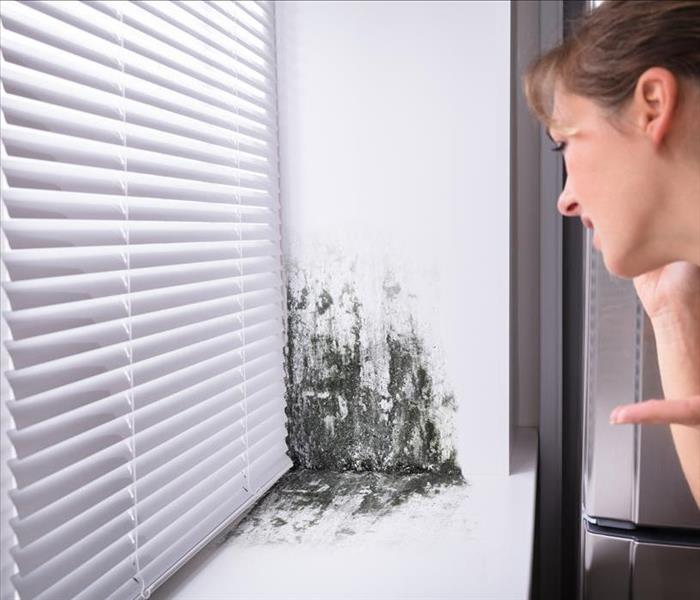 Mold thrive in places with high moisture.
Mold thrive in places with high moisture.
Most homeowners are familiar with the type of mold that grows on their shower curtain or the food that has been in the fridge for too long. However, when stories about black mold started making the news, many people became much more concerned about it. This is a brief overview of what mold is.
Facts About Mold
What Mold Is
Mold is a kind of fungus. Mold can live almost anywhere but tends to thrive in places with high moisture. Small amounts of mold are present in most environments but do not become problematic until they begin to rapidly reproduce due to changes in the environment, such as a moisture problem, that promote their growth. Mold can be one of several different colors:
- Black
- Orange
- White
- Green
- Purple
Where Mold Grows
Mold can grow on floors, walls, appliances, carpet or furniture. It tends to grow more rapidly in moist conditions, which makes mold more common in bathrooms, laundry rooms, kitchens, crawl spaces and basements. However, black mold and other types of mold can also become a problem in homes with water damage from floods, severe storms or leaks, which makes prompt water remediation an important defense against mold problems after water damage has occurred.
Mold Prevention Tips
One of the most effective ways to avoid mold problems is to promptly address any moisture issues in your home. If your home has water damage, contact a professional in Salt Lake City, UT, to remove the source of the water and dry out your home. If you find mold growth, the earlier mold cleanup is done, the better chance you have to prevent the problem from spreading throughout your home.
Black mold and other types of fungus can cause severe property damage when left untreated. However, you can mitigate this problem by quickly eliminating sources of excess moisture and promptly removing existing fungus issues in your residence.
3 Ways Business Interruption Insurance Protects Your Business
3/15/2021 (Permalink)
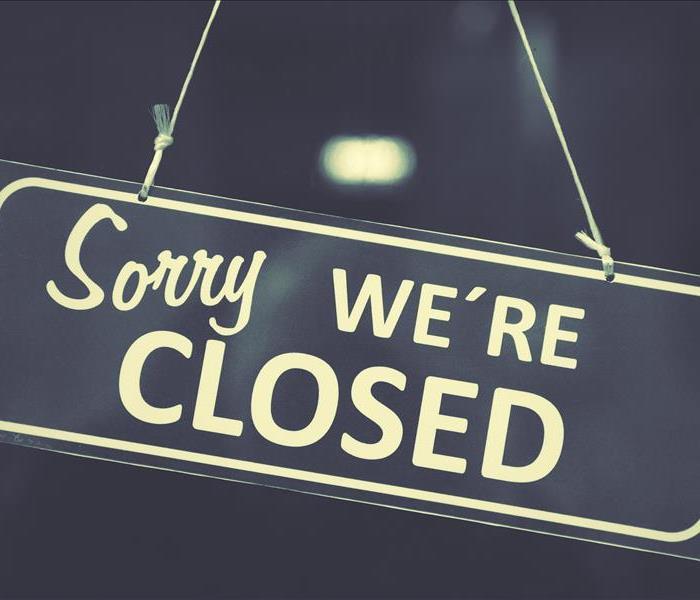 Protect your business with interruption insurance
Protect your business with interruption insurance
Interruption insurance provides coverage for income lost due to damage to a business caused by a covered cause of loss. There are multiple ways that this coverage helps protect your business, including these three.
3 Ways That Business Interruption Insurance Protects Your Business
1. Replaces Lost Income
If a covered cause of loss causes damage to your property that results in lost income due to a business interruption, destruction of inventory or another issue, your insurance will compensate you up to the limits of the policy. The amount of reimbursement is based on your preloss earnings and is usually calculated as revenues less ongoing expenses. For example, if a severe storm damaged your roof, leading to water damage in your building that forced you to close while a restoration service in Salt Lake City, UT, worked to dry out your building, you may be compensated for the lost revenue that resulted from that closure.
2. Covers Extra Expenses
In addition to replacing lost income, interruption insurance provides reimbursement for extra expenses incurred due to damage from a covered cause of loss. For example, if your building was damaged in a fire and you had to temporarily move your business to a different location while fire restoration repairs were being made, the cost of moving to and renting that location would be covered as an extra expense.
3. Helps Businesses Re-Open Faster
Without coverage for lost income and extra expenses, many businesses struggle to make payroll and cover ongoing expenses after a loss. This can cause some businesses to close permanently. Business interruption coverage makes it easier for businesses to cover immediate expenses and return to operations as quickly as possible.
Interruption insurance protects businesses from the financial risks of not being able to operate during the period between when damage occurs and when the business can resume normal operations. An insurance professional in your area can help explain how this coverage can benefit your business.
Three Steps for Safety as a First Responder
2/24/2021 (Permalink)
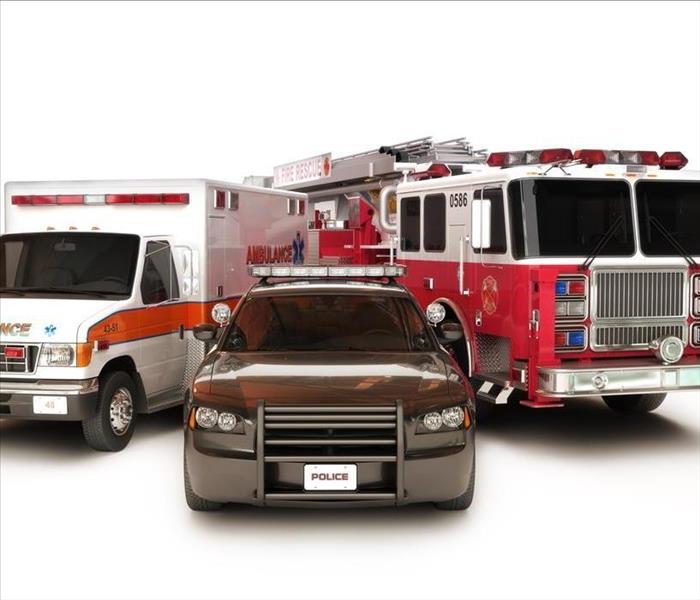 First responder's safety is important.
First responder's safety is important.
As a first responder in Park City, UT, your ability to keep others safe is dependent upon your own safety and well-being. This means that you have a responsibility to prepare yourself, as well as your home and family for possible flood disasters.
3 Steps for Safety
1. Develop Appropriate Handwashing Skills
As a first responder, handwashing is one of your most valuable means of avoiding illness and sharing illness with family members. Don't rush through this task:
- Use running water when possible.
- Lather enough soap to cover all parts of your hands, fingers (including fingernails), and wrists.
- Scrub your hands, between your fingers, under your nails, and over your wrists for at least 20 seconds.
- Rinse thoroughly under running water.
- Dry hands with a towel or allow your hands to air-dry.
Finally, avoid touching your face as much as possible.
2. Stay Up to Date With Vaccinations
Immunizations, such as a Hepatitis B vaccination and a new tetanus booster every ten years can help you avoid serious illness as you come into contact with a variety of contaminants, especially when you are part of a flood response. The CDC also recommends the rabies vaccine series in case of exposure to potentially rabid animals. As always, check with your medical professional for more information.
3. Personal Protective Equipment
When emergency restoration professionals arrive at your home to address necessary cleanup and repairs, they'll probably arrive in waterproof clothing, heavy-duty boots and gloves, eye protection, and protective masks. You should have access to the same. This type of PPE provides a barrier between your skin and contaminants in the floodwaters. After your work, remove this equipment in an isolated space and store it in a plastic bag away from your other clothes.
Just Three Steps
Take the time to thoroughly wash your hands. Get recommended vaccinations. Suit up in personal protective gear. These three simple steps can you stay safe as a first responder, so you are able to carry out your responsibilities on the job and at home.
Tips for Choosing the Right Fire Extinguisher for Your Home
2/23/2021 (Permalink)
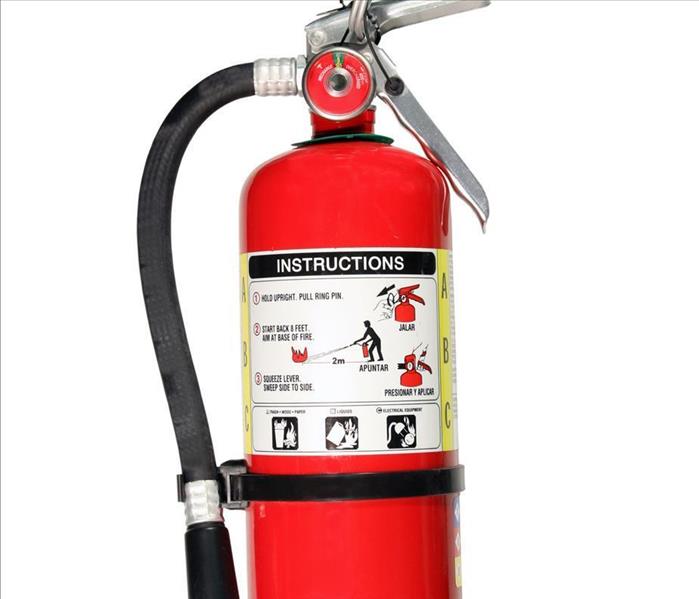 Choosing the right fire extinguisher for your home can help you avoid further fire damage.
Choosing the right fire extinguisher for your home can help you avoid further fire damage.
No homeowners like to think about a fire breaking out in their homes, but having a proper safety plan means preparing for the worst case scenario. Sometimes, the fire starts as a small, manageable flame that you can put out yourself, but in order to do this effectively, you have to have the right fire extinguisher within reach. Here are some tips for choosing the appropriate models for your home in Salt Lake City, UT.
3 Things to Consider When Choosing the Appropriate Fire Extinguisher
1. Effectiveness
A home fire can be caused by several issues:
- Ignited combustibles, such as wood or textiles
- Flammable substances, such as grease or gasoline
- Electrical problems
Some extinguishing agents work better on typical combustibles than others. You want to either make sure the label on your extinguisher indicates that it can cover all three categories of fire or purchase multiple extinguishers to place near high risk areas such as the kitchen.
2. Placement
There are several areas throughout your home where you need a fire extinguisher. Fire restoration experts recommend that you have an extinguisher in your garage and any other area where you work with electricity or flammable materials. You need one near your kitchen so that you can put out any fires that happen while you are cooking or baking, and you may consider adding an additional extinguisher within arm's length of the stove itself. Because of the risk of lint fires, you should also have an extinguisher in the laundry room. Since a home fire can break out anywhere, though, it's smart to have enough extinguishers that there is always one within a short distance.
3. Size
The size of the extinguisher depends on its potential use and the area it may have to cover. For large open spaces, a 10-pound extinguisher is appropriate. Most of the canisters throughout your home should be 5-pound models to cover smaller spaces. A 2-pound portable extinguisher is useful to have in your car.
Unless your home is very small, you likely need more than one fire extinguisher. Knowing what to buy and where to put them is a vital part of your fire preparedness plan.
Tips for Maintaining Your Fire Sprinkler System
2/22/2021 (Permalink)
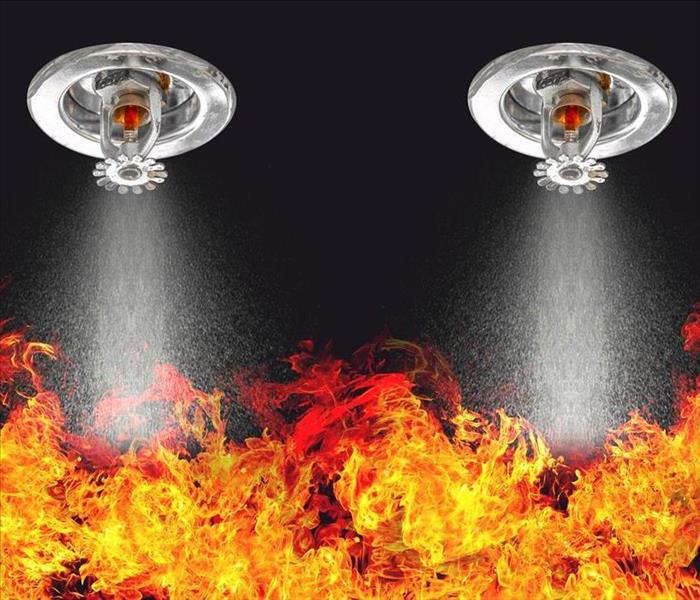 Proper sprinkler maintenance can protect your business from further damage.
Proper sprinkler maintenance can protect your business from further damage.
If not serviced properly, a sprinkler based suppression system go off accidentally, causing massive water damage to a business. You might even have to find a water remediation company in Park City, UT to repair the damage. Fortunately, there are some sprinkler maintenance tasks that you can do to avoid accidental activation.
Tasks for Fire Sprinkler System Maintenance
Schedule Regular Maintenance
Sprinkler systems have to be checked and serviced at regular intervals. Contact your systems contractor:
- When your yearly maintenance comes up
- Every fifth year for a full pipe inspection
- If a sprinkler head is damaged
- When you notice any rust or decay
Regular sprinkler maintenance by a systems contractor is essential to the health of your system. It can keep your system running correctly and save you thousands in damages due to accidental activation.
Avoid Blocking the Sprinklers
It is extremely important that the sprinkler heads remain clear of any furniture, supplies or other materials. When they are covered or hindered, they cannot put out a fire effectively. Blockages also interfere with heat and smoke sensors. Each head needs at least 18 inches of clearance between the sprinkler and anything beneath or around it.
Check Your Sprinkler Caps
You can check these yourself. The sprinkler caps are also called Fire Department Connections and are located outside of your building. These water intake caps allow your local fire department access to your sprinkler system. They can link their equipment into the network of fire sprinklers and use it to help fight the fire in your building. You will want to check these around every third month.
Visually Inspect Pipes
A visual inspection of your pipes can save you time and money down the road. Signs of rust, decay or leaks are easily spotted before they become a serious problem. Look for white edges and rust, particularly around pipe joints. These are early signs that the pipes might be failing.
An automatic sprinkler system is one of the best precautions you can have against a fire. Proper sprinkler maintenance can help keep your sprinklers functioning perfectly.
How To File a Flood Damage Claim After the Disaster
2/11/2021 (Permalink)
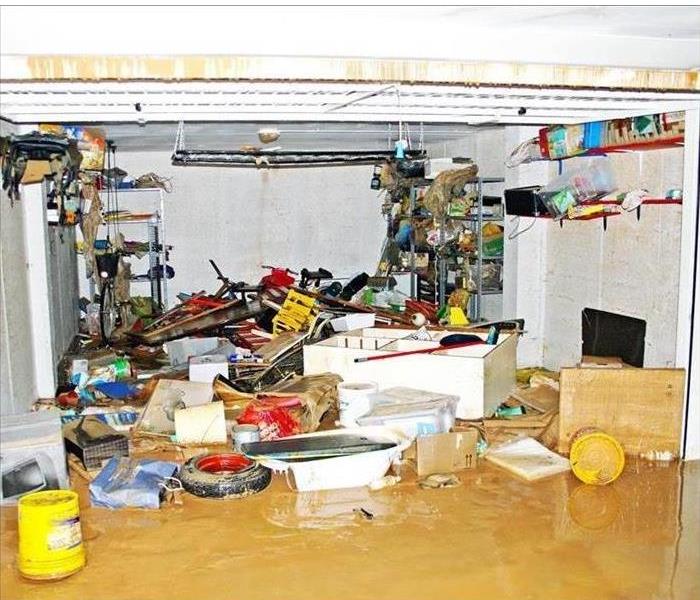 Flood damage in Salt Lake City, UT.
Flood damage in Salt Lake City, UT.
If your home in Salt Lake City, UT, was flooded by a natural cause or disaster, it’s time to file a flood claim. This can help you get the funding you need to recover from the damage. However, filing an insurance claim can be confusing. Here are three things you can do to successfully make a claim.
Three Things To Do To Make a Claim
1. Start the Process
The first thing you can do is notify your insurance agency of the flood. Do this as quickly as possible so that an adjuster can contact you within the next few days. You can discuss what action to take and what you should be doing on your end while you wait. Be sure to have the name of your insurance, the policy number, and your phone number ready.
2. Document Everything
Next, photograph the damage. It’s important to document everything that was damaged during the flood so that you have evidence of what losses you suffered. Take pictures and videos of your entire home. You can also make a list of damaged or lost items and use that in your flood claim. Don’t forget to place damaged items outside to prevent mold growth within the house.
3. Back Up Your Claim With a Proof of Loss
With the help of your adjuster, you can create a Proof of Loss to prove that you are claiming the correct amount of money. This contains specific details concerning the damage from the flood and must be filed within 60 days of the disaster. Once you and your insurance company agree on the amount, the claim payment should come.
Insurance can be beneficial when dealing with the water restoration process, and filing a flood claim doesn’t have to be complicated. By carefully and concisely compiling evidence and keeping in touch with your insurance company, you can file the claim and receive payment. Keep in contact with your insurance company to find out how you can best receive the help you need.
Keep Mildew Out of Your Bathroom
1/25/2021 (Permalink)
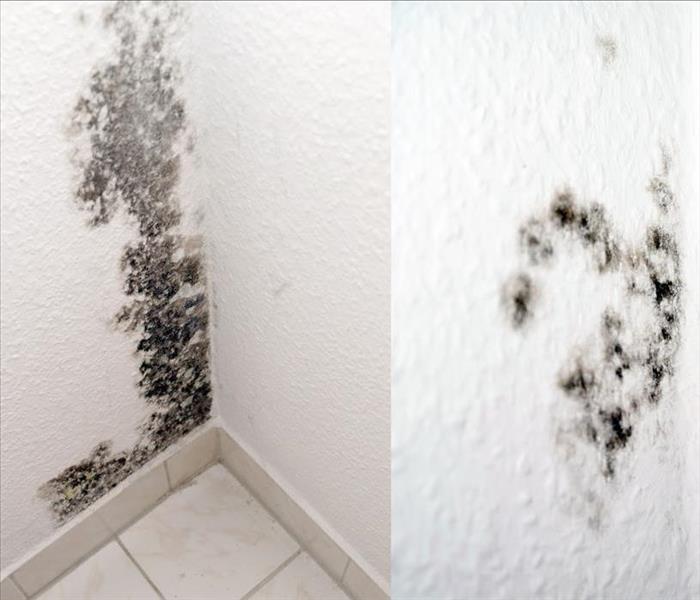 Prevent bathroom mildew or mold
Prevent bathroom mildew or mold
Whether you live in an area where humidity is a consistent problem or you only occasionally deal with excess moisture, knowing how to prevent mold growth is vital to preventing mold from growing in your Salt Lake City, UT, bathroom.
Prevent Mold Growth in Your Bathroom
The first step is identifying the main causes of your humidity problem:
- It's normal to enjoy the feeling of a hot shower with plenty of steam, but this lack of proper ventilation is one of the leading causes of mildew growth. It's best to run a fan, leave the bathroom door open when showering, or open an outside window.
- Make sure that the people showering in your home don't leave damp towels lying around or neglect to air dry the shower rug.
- At least once a week, it's important to clean the toilet and shower with commercial cleaners.
- The deterioration of tiles, grout, and floorboards allows moisture to get behind the walls and under your flooring. Keep a close eye on your grout. Some experts recommend replacing shower grout once or twice a month.
Make it a habit to reduce moisture and humidity in the bathroom to discourage new growth.
Identify Existing Trouble
If you already have evidence of mold or mildew, take steps right away to clean and correct it. The most common types of bathroom mildew or mold include Aspergillus, Cladosporium, and Stachybotrys (or black mold.) Because it is hard to know which type of mold is present, it's best to hire water damage cleanup professionals to test for and get rid of mold. Professionals have access to equipment and supplies for testing which types of mold are present and determining how widespread the mildew has grown.
Repel Mold Growth
Mold loves to grow in warm, damp areas, and the environment in bathrooms is often very inviting for floating spores. In addition to providing this inviting atmosphere, the bathroom also has plenty of hidden nooks and crannies where mold spores can settle and support new colony growth.
The first steps for preventing bathroom mildew include increasing ventilation, removing wet clothing and towels, and replacing damaged grout.
How To Administer First Aid for Burns
1/19/2021 (Permalink)
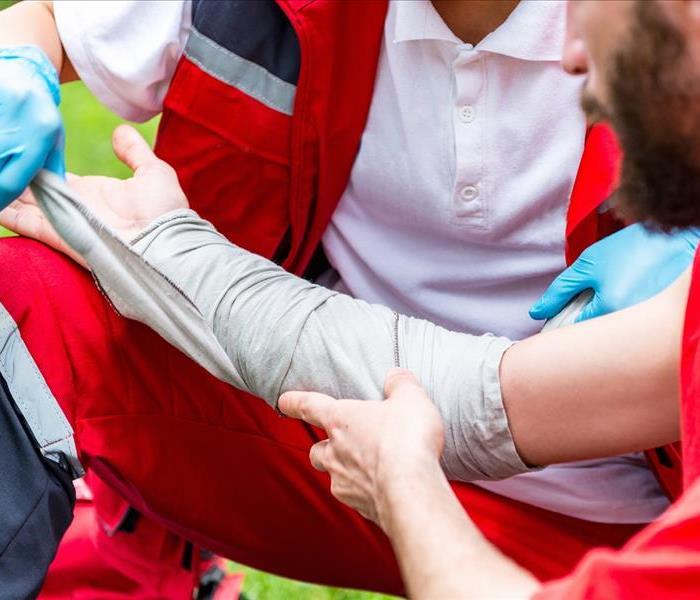 Know how to administer first aid for burns
Know how to administer first aid for burns
A fire in your commercial building in Salt Lake City, UT, not only has the potential to cause costly fire damage to the structure but also can put people in danger of burns as they try to escape. Knowing some basic first aid for burns is necessary for situations such as this.
First Aid For Burns
Severity Assessment
The first thing you must do before any burn first aid is applied is determine how severe the injury is. Look for symptoms associated with major burns:
- Deep wound
- Dry or leathery skin
- Charred area with black, brown or white patches
- Circumference larger than 3 inches
Minor Burn Care
If a small area of burned skin is merely red and hot or has a few blisters, similar to a bad sunburn, the person likely only has a minor burn. Once they are clear from the fire damage of the burning building, start by cooling the burn with running water or a cool compress. Once it has cooled completely, you can apply a soothing lotion such as aloe vera to provide comfort and keep the skin from drying out. Bandage the burn loosely with a clean, lint-free cloth or gauze. The patient can also take an over-the-counter pain reliever.
Major Burn Care
First aid for major burns is a little different. The main goal of treating a major burn is to keep the person calm and safe until professional help can arrive. After you have called for emergency medical personnel, cover the burn with a loose cloth, but don't submerge it in water. Remove any jewelry and loosen tight clothing, as major burns can cause the area to swell. Keep an eye out for signs of shock such as fainting or shallow breathing, and keep the burn elevated above the heart if possible.
Fire restoration experts can take care of the fire damage to your building, but making sure injured people get the first aid they need depends on those around them. Knowing the correct action to take can save them a lot of pain in the long run.
Where to Start when Restoring a Flooded Basement
1/18/2021 (Permalink)
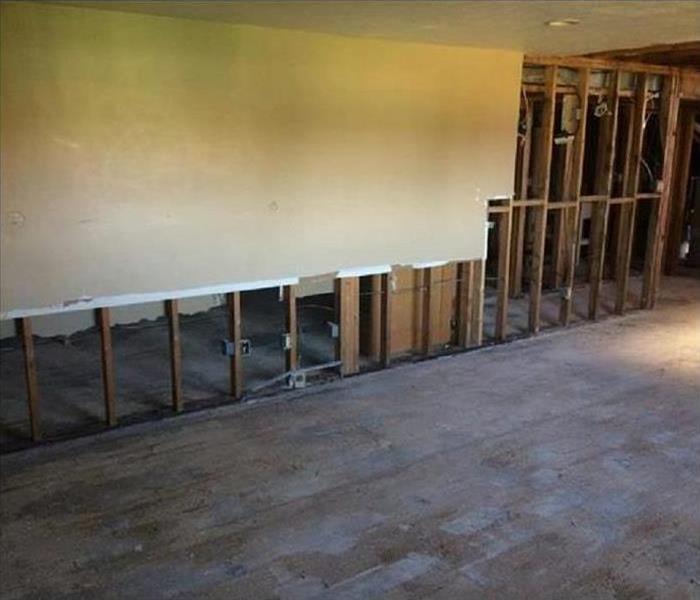 SERVPRO performed flood cuts to remove all water damaged materials in Park City, UT.
SERVPRO performed flood cuts to remove all water damaged materials in Park City, UT.
When flood season comes to Park City, UT, it can hit hard. The impact of the excess water is most likely to be felt by homeowners in the form of basement flood damage. Whether the sump pump failed or just couldn't keep up with the water flow, homeowners may be left scratching their heads. Feelings of where to start and what to do can be overwhelming. The following three steps may give some direction as to how to approach flood cleanup and prevention of future incidents.
3 Steps to Cleanup Flood Damage
- Remove Water
Before any repairs can be made, all of the water must be removed from the basement. Some people prefer to call a water removal and restoration company for assistance. Flooded basement water removal may look something like the following:
- Hiring an electrician to evaluate the risk of electric shock.
- Getting the sump pump up-and-running to remove sitting water.
- Using a shop vacuum to suck-up the last inch or so of water.
- Lifting carpet and using large fans to dry-out moisture.
- Sanitizing with warm water and disinfectant to prevent mold growth.
- Repair Damage
Once the area has been completely dried, repairs may be in order. Checking your home flood insurance coverage may be a good place to start. While salvaging some belongings may be an option, it is unwise to try to save anything which uses electricity or gas. If your gas furnace or electric outlets took on water in the flooding, replacement over repair is the safe route to go.
- Plan for Future Flood Prevention
Now that the basement is clean, dry and repairs are complete, it's time to plan ahead for the future. There is nothing worse than putting time and money into basement flood restoration only to have it ruined all over again. Consider the following preventative measures:
- Install a back-up pump.
- Create outside drainage for storm runoff.
- Buy a generator for use during a power outage.
Flooding in Park City, UT, is common. If a basement flood catches you by surprise, follow these three basic tips to get cleanup underway.





 24/7 Emergency Service
24/7 Emergency Service





























































